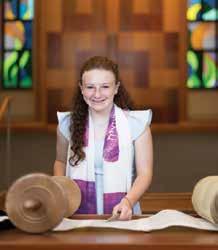

Name That Couple...




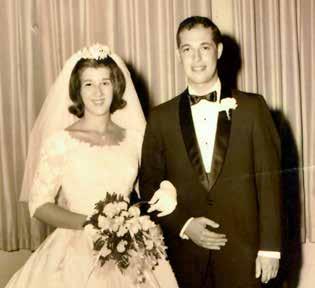




The Temple Cultural Arts presents:

A Concert of Healing & Light

This concert brings together multiple choirs in a powerful musical commemoration of Kristallnacht, transforming remembrance into a shared journey of resilience, hope, and harmony. Featuring The Temple Singers and members of the Atlanta Symphony Orchestra joined by choirs from:
• Congregation Bet Haverim, Atlanta
• First Presbyterian Church, Atlanta
• Holy Blossom Temple, Toronto
• Kol Zimrah Jewish Community Singers, Chicago
SUNDAY NOV 09 2025 4PM
Students: $25 (with student ID)
To purchase tickets, scan the QR code above or visit www.the-temple.org/concert
• St. Luke’s Episcopal Church, Atlanta Reception to follow. Tickets: Adults: $36
Atlanta’s Favorite Real Estate Team
Atlanta has been part of my story since I was three months old, and nothing brings me more joy than helping others discover their place in this city I love. With almost 7,000 sellers and buyers proudly served, my team delivers results with heart, hustle, and hometown pride.
"Zac Did It Again!" speaks to our consistency and our clients' confidence. Discover for yourself why we’re Atlanta’s Favorite Real Estate Team!
Zac Pasmanick, Team Leader ZacSellsAtlanta.com 404-564-7272 | zac@zac.biz We’re Hiring! We have two open opportunities for a coachable agent with a great attitude and a strong commitment to customer service.
















PUBLISHER
MICHAEL A. MORRIS michael@atljewishtimes.com
EDITOR & MANAGING PUBLISHER
KAYLENE LADINSKY kaylene@atljewishtimes.com
Execuitive Assistant
RONIT FRANCO-PINSKY ronit@atljewishtimes.com
EDITORIAL
Managing Editor
SASHA HELLER sasha@atljewishtimes.com
Staff Writer & Proofreader
FRAN PUTNEY fran@atljewishtimes.com
Interim Online Content Coordinator
ROBERT GARBER robbie@atljewishtimes.com
CONTRIBUTORS THIS ISSUE
BOB BAHR
CHANA SHAPIRO
DAVE SCHECHTER
RABBI DAVID GEFFEN
DAVID OSTROWSKY
DEBBIE DIAMOND
MARCIA CALLER JAFFE
SHAINDLE SCHMUCKLER
ADVERTISING
Senior Account Manager & Team Supervisor
MICHAL BONELL michal@atljewishtimes.com
Account Manager ILYSSA KLEIN ilyssa@atljewishtimes.com
CREATIVE & DESIGN
Creative Director
LILLI JENNISON lilli@atljewishtimes.com
COMMUNITY ENGAGEMENT
Events Director
JACQUELINE MORRIS jacqueline@atlantajewishlifefoundation.com
Atlanta Jewish Connector Coordinator DIANA COLE diana@atljewishtimes.com
GENERAL OFFICE
ROBIN FREEDMAN info@atljewishtimes.com 404-883-2130
Distribution Manager
LOU LADINSKY lou@atljewishtimes.com




Cover Photo: These nine Atlanta Jewish Times’ long-married couples (averaging 60 years) revealed some of their long-married secrets.
Marcus Foundation Grant Propels ARA’s Growth
By Bob Bahr
The Atlanta Rabbinical Association has received a new three-year grant from the Marcus Foundation that is being touted as giving the 30-year-old organization new energy and a new direction. The grant for the association, which represents about 100 of the city’s rabbis, is designed to broaden their influence in the general community and to enhance the opportunities for further study at Emory University.
The ARA’s president, Rabbi Brad Levenberg of Temple Sinai in Sandy Springs, described the funding as transformational.
“The grant is large enough to really transform what we do and how we do it,” Levenberg said. “This is a grant that will help to professionalize the organization, and I think, really prepare us for a new era of leadership in the city.”
The program is formally being launched on Nov. 18 with a day-long Rabbinic and Leadership Conference at Temple Sinai. The program, which has been

developed with Emory’s Candler School of Theology, is the first of three such meetings that will take place each year.
The November conference, which is being promoted as helping to build “the future of Jewish leadership,” comes at a
time of what the organization describes as “a time of profound change for Jewish communities.”
“This program addresses the growing need for innovative leadership models to support rabbis and nonprofit leaders as they navigate pressing challenges — including declining participation, evolving generational expectations, and financial strain.”

ARabbis will have the opportunity at the conference to hear from Emory

t Canterbury Court senior living community, great food is always on the menu—whether it’s a chef-prepared lunch or fine dining. Add a glass of wine and it’s the perfect setting for getting to know your new neighbors. Plus, you’ll enjoy a new, elegantly finished apartment home and enhanced amenities and services. And the peace of mind of a continuum of care, if ever needed. With all this awaiting you, what are you waiting for?
To learn more and to schedule a personal tour, contact us today at 404-737-2639, visit
CanterburyCourt.org/Nosh, or scan the QR code.
3750 Peachtree Road, N.E.
Atlanta, GA 30319
The grant from the Marcus Foundation is designed to help the Atlanta Rabbinical Association develop an expanded role in the Atlanta community,

Much of the initial work for the grant was done by Rabbi Daniel Dorsch of Congregation Etz Chaim.
experts about how to deal with their increasingly problematic future and help them explore and develop new strategies for enhancing their moral leadership.
Rabbi Levenberg sees the Marcus grant as building on Atlanta’s effective model of uniting civic and business communities with religious leaders to bring about social change.
“I think that it’s a realization that we owe something to the faith leaders of our past to be able to be more engaged in the city than perhaps we have been in the past.”
The foundation for the program was largely created by the work of Rabbi Daniel Dorsch, senior rabbi at Congregation Etz Chaim in Marietta, who completed his two-year term as president of the organization in May of this year.
Much of his work dealt with clarifying how rabbis see their organizations and how it might be repositioned to deal with the many challenges they face today. A pair of rabbinic meetings held in March and April of this year, according to Levenberg, led to a proposal to the Marcus Foundation.
“From those conversations emerged a new mission, a new vision and some new threads,” Levenberg noted. “It became apparent that we are an organization that leads together, learns together, and even leans on each other for support. So, from these meetings the ARA created what’s known as the Now and Next Document. It’s a list of goals to accomplish over the next few years.”
Helping the organization in their effort to clarify their future work has been Rabbi Ira Bedzow, executive director of Emory’s Purpose Project, which is designed to help students sharpen their

Temple Sinai’s Rabbi Brad Leventhal, president of the ARA, sees the Marcus grant as transformational.
focus on purpose and meaning in their lives. As an ethicist, who is also affiliated with Emory School of Law, he has often written about how best to approach change.
He believes that trying rather than “being blown over by uncertainty, personal and professional achievements can be realized if one harnesses the winds of change in ways that speak to who you are and what you believe in.”
Under the terms of the new agreement, Rabbinical Association rabbis will be able to access coursework, not only at Emory’s Divinity School but across the university. Credits can be applied toward a master’s degree.
Rabbi Levenberg believes the partnership with Emory will be particularly meaningful for young rabbis who are in the early stages of their career.
“The opportunity is for newer rabbis in Atlanta to be able to enhance their skills by going to Candler. They might be the skills that they didn’t get in seminary, or perhaps the skills that they didn’t realize they would need to be more fluent in in their practice now in Atlanta.”
For the first time in their history, the grant also provides the ARA with formal office space. They will be located at The Dupree in Sandy Springs close to Rabbi Levenberg’s temple offices.
In an effort to further professionalize the work of the organization, the Marcus grant has also provided for an expanded role for the organization’s program and operations manager, Brooke Rosenthal. She is the wife of Rabbi Laurence Rosenthal, senior rabbi of Ahavath Achim Synagogue, who is also a former president of the organization. ì

OPENS NOV 6 ATLANTIC STATION
Blank Foundation Gives $50M to Local HBCUs
By Bob Bahr
Four of Atlanta’s historically Black colleges and universities will share a $50 million scholarship fund initiated by the Arthur Blank Family Foundation. The large commitment begins next year and will be spread out over the following 10 years. It will provide financial aid for students at Clark Atlanta University, Morehouse College, Morris Brown College, and Spelman College.
The scholarships are expected to provide financial support to an estimated 10,000 students to help increase graduation rates at the four schools. Financial hardship rather than academics, there, can cause students to drop out. In announcing the new funding, Arthur Blank, chairman of the Foundation, reiterated his support for the educational institutions.
“Our hope is that by helping more students earn their degree, launch successful careers, and become alumni who give back, we are investing in a cycle of opportunity that benefits young people and

their families in Atlanta and communities across the nation for years to come.”
The Foundation’s multi-milliondollar contribution will provide what are


termed gap scholarships. This form of financial aid is aimed at providing assistance to students who are close to graduation but may need additional support
to fill the gaps that might prevent them from finishing. According to Fay Twersky, president of the Blank Foundation, the program will help students stay en-


The Arthur Blank Family Foundation will donate $50 million to Atlanta’s historically Black colleges and universities over the next decade.

The Arthur Blank Family Foundation’s $50 million donation will support students at Clark Atlanta University, Morehouse College, Morris Brown College, and Spelman College.
rolled and graduate on time.
“Even a small financial gap can be the difference between walking across the graduation stage and walking away,” Twersky said. “We are proud to stand with Atlanta’s HBCUs and help more students achieve their dreams.”
The scholarships will be available to students who maintain acceptable academic standards but have fully exhausted all other financial aid, including state and federal student loan programs. Included in these programs are Pell Grants from the federal governments which provide money to low-income undergraduates and do not have to be repaid.
According to the foundation, students applying for Pell Grants tend to take out more student loans and are at a greater risk of leaving school before they have earned a degree. It is estimated that students who are able to graduate will earn 57 percent more in their lifetime than those who don’t.
The philanthropic hand Blank has extended to students of the Black colleges has also included the colleges themselves. The president of Morris Brown College, Dr. Kevin James, leads an institution which has previously received a $3 million grant from the Blank Foundation. It was used to develop a yearlong hospitality credential program.
Morris Brown College has led a precarious existence over much of the past 20 years. It lost accreditation in 2003 and was forced to declare bankruptcy in 2012.
When Dr. James took over at the college in 2019, only 20 students were enrolled in the institution. The loss of accreditation meant the loss of federal funding and student loan programs and those students were largely on their own.
Following a period of financial restructuring, accreditation was restored in 2022. It was the first HBCU to do so after two decades as an unaccredited
college. Federal loans, particularly the Pell Grants, which are so important to so many students, began to flow again. Current enrollment is about 300 undergraduates. Generally, historically Black schools have faced far greater economic challenges than predominantly white institutions that often have greater endowments and richer alumni.
The latest gift by the Blank Foundation follows a history of giving to Black higher education that has approached $20 million in Atlanta in recent years. Over half of that was a $10 million gift in 2022 for an Innovation Lab at Spelman College.
The president of Morehouse College, Dr. F. DuBois Bowman, whose school had previously received $400,000, hailed the Blank Foundation gift as a way to remove some of the financial pressure that his students face.
“This monumental investment will empower our students to remain focused on their academic studies.” Dr. Bowman said, “and ensure that their talent, ambition, hard work, and integrity, not financial hardship, will determine their futures.”
Although the 100 HBCUs in the United States make up only about 3 percent of all institutions of higher learning in this country, they educate 10 percent of all Black students. According to the United Negro College Fund, they award 17 percent of all bachelor’s degrees given to Black students and 25 percent of all degrees given to Black students in the field of science, technology and mathematics.
The latest Blank gift follows a grant of $70 million last month to the UNCF from philanthropist MacKenzie Scott. It was described as a “transformational” bequest to strengthen Black colleges and universities. The UNCF is hoping to raise $1 billion to increase the financial backing of the college and universities it represents. ì


Coming Off GLP-1: Does the Magic End?
By Marcia Caller Jaffe
Scientists are fervently studying how the GLP-1 class of fairly well tolerated weight loss drugs has affected public health, how to stay on them, and what happens when the dosage is tapered and ultimately terminated? Dietitians concur that it is a tool and not magic. Common GLP-1 medications are Zepbound and Wegovy.
Registered dietitian Cheryl Orlansky “weighs” in on her approach to a healthy off ramp. She related, “We still have so much to learn in long-term maintenance of weight loss with GLP0-1s. We are seeing 10 to 20 percent weight loss with GLP-1s. But we’ve seen substantial weight gain when stopping the medication. There is potential for slowing the rate and amount of weight gain. We use a personalized approach to help maintain weight after stopping the medication. It may be that we use a smaller dose and less frequent timing to help people keep the weight off. Counseling remains the same, but we may need a more intensive approach.”

According to The Guardian (May 15, 2025), clinical trials and reviews show that a large fraction of weight loss tends

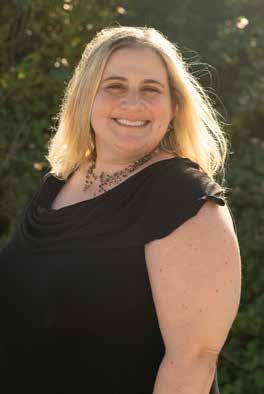

to return within a year of cessation. Thus, what if the treatment is long term or lasts a lifetime for many to maintain results? The long-term data past two to
three years is not yet documented.
Compared to meds previous to GLP1, Orlansky said, “These agonists have been a game changer used as a tool and



GLP-1 drugs have been extremely effective with weight loss.

adjunct for lifestyle measures as they mimic a hormone naturally produced in the body called GLP-1 that slows digestion and helps regulate appetite. GLP-1/ GIP agonists also mimic the hormone GIP which plays a role in insulin production and cholesterol metabolism. Overall, these medications promote weight loss by decreasing appetite and making it easier to eat a lower calorie diet (no hunger or “food noise”) for sustainable weight loss.”
Historically, GLP-1s were used in people with diabetes starting with twice daily injections of Byetta in 2005. Victoza was approved in 2010 in a once daily injection to reduce blood sugars and control A1C still in people with Type 2 diabetes.
These medications worked well to manage blood sugars and observers saw the weight loss side since many people with Type 2 diabetes may also be overweight or obese. Tirzepatide and semaglutide are now indicated for people who need to lose weight, but don’t necessarily have prediabetes or diabetes.
Orlansky sees some trends toward smaller portion sizes in restaurants, more protein-rich meals and snacks, and reduced alcohol consumption, since these medications reduce cravings for alcohol as well. Orlansky added, “We may be seeing a reduced consumption of ultra-processed snacks and sugary beverages which would be a huge win for society.”
Healthcare and public health policy is moving toward labeling obesity as a
chronic disease like hypertension or hyperlipidemia. Orlansky shared, “We are not using the term ‘will power’ or ‘just cut back on calories and increase your metabolic burn.’ We know that there are many factors that play a role in overweight and obesity.”
Many health organizations recommend GLP-1s as a first-line treatment in diabetes and obesity. This could help insurers and employers with cost. Weight Watchers has added GLP-1 telehealth.
Orlansky concluded, “Stopping the medication will cause weight regain. We need a gradual approach. We are slowly moving people toward their starting dose and decreasing the frequency of the injections.”
Her counseling remains the same with individualized variations. Diets should be varied, fiber rich, with plant or animal protein at each meal, and she recommends the Mediterranean, plant forward diet as a good framework.
Orlansky is a registered, licensed dietitian nutritionist and certified diabetes care/education specialist. She worked as a contractor for Centers for Disease Control and Prevention in weight management for their employees. She then started the Nutrition and Diabetes Program at Laureate Medical Group, a multidiscipline physician practice part of the Northside Hospital Network. Currently, she counsels patients using telemed for conditions including GI, diabetes, and weight management.
For more information, please email orlanskynutrition@gmail.com. ì






Dietitian Cheryl Orlansky counsels patients with GI, diabetes, and weight management conditions.
Regenstein Debuts in Historical Film
By Marcia Caller Jaffe
Storied Atlantan and author Lewis Regenstein added another paragraph to his resume headed “movie star.”
Well, more Ken Burns than George Clooney, but nonetheless he appeared in the documentary “This Happy Land,” which brings to light the plight of Jewish immigrants, fleeing widespread pogroms, peril and persecution in Europe, and began arriving in the Southern United States in the 1600s, where they were generally welcomed and treated with friendship and respect.
The hookup was through director Michael Givens who had seen some of Reggie’s articles and reached out. The actual interview was taped at Regenstein’s Buckhead home, over several hours alongside furniture magnate and film funder Jack Schewel.
Givens, the film’s co-producer/director, explained that “the documentary vividly portrays the shared patriotism and solidarity between Southern Jews and Christians. Through personal stories and historical accounts, ‘This Happy

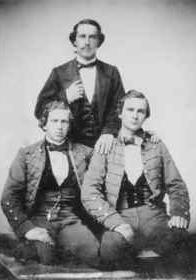
Land’ illustrates a time when Jews were overwhelmingly accepted and thrived in their new homeland, viewing the South as their New Jerusalem.”


As part of his “stardom,” Regen-
stein was touted at the film’s premiere in Charleston on Sept. 20, which was held at the Queen Street Playhouse. Charleston was chosen because it was the largest Jewish community in America in the
1800s. Proceeds from the opening benefitted The Jewish Historical Society of South Carolina.
At the event, Regenstein recalled, “they paid rapt attention and stayed for





Lewis Regenstein recalls the drama and tales of his ancestors, some of whom fought in the Civil War.
Lewis Regenstein’s ancestors, the three Moses brothers who fought for the South.

The Arthur M. Blank Center for Stuttering Education and Research
Leading groundbreaking discoveries, reducing global stigmatization, training the future, and providing life-changing CARE worldwide that empowers children, teens, and adults worldwide to
Dream. Speak. Live.

the entire three-part showing. Mainly ‘old family’ Jewish Charlestonians, most of whom attend Beth Elohim Congregation right around the corner, the oldest continuously operating Reform congregation in America, founded by my great-great-grandfather, Isaac Harby, and other Charleston pioneers of the Reform movement in America.”
Regenstein appeared in about 12 scenes totaling a few minutes of commentary, mostly about his family’s early American history, some of which was published in the Atlanta Jewish Times as an interview with Regenstien’s mother, Helen, “Buckhead Doyenne Saluted at 101.” (Nov. 6, 2019)
She had three direct ancestors who fought for the American Revolution.
Regenstein detailed those ancestors, including the infant daughter of family patriarch Myer Moses, Rachel, who was killed sitting on her nanny’s lap when a British artillery shell hit their home during the siege of Charles Town. She was the only Jewish female known to have been killed in combat during the Revolution.
Other Regenstein ancestors who fought for the South during the Civil War and are featured in the film are his great-grandfather, Andrew Jackson Moses, his four brothers and their uncle, Major Raphael Jacob Moses, known as “ the father of Georgia’s peach industry,” who attended the Last Meeting and carried out The Last Order of the Confederate Government.
The film includes interviews with leading Jewish scholars, historians, authors, and rabbis, including notable Atlantans Debra Jacobs and Jay Tanenbaum, board members of the Museum of Southern Jewish Experience in New Orleans; and attorney Ivan Millender.
For distribution updates at theaters and film festivals, please visit ThisHappyLand.us for details. ì
Establish peer-to-peer relationships
Improve communication competence
Enhance selfcompassion and self-advocacy
THE BLANK CENTER’S MISSION
Lessen the influence of stuttering
The Arthur M. Blank Center for Stuttering Education and Research at The University of Texas Moody College of Communication is changing the world for people who stutter through three core branches: training (Lang Stuttering Institute), research (Bodner Developmental Stuttering Lab), and treatment (Dealey Family Foundation Stuttering Clinic). Dr. Courtney Byrd, the Blank Center’s Founding and Executive Director, has been building a stuttering program at UT since 2003. With its flagship at UT Austin, satellite center in Atlanta, GA, and program o erings worldwide, the Blank Center’s distinct CARE (Communication, Advocacy, Resiliency, and Education) Model empowers the stuttering community worldwide to Dream. Speak. Live.
Contact Information
For more information about the Atlanta Satellite and how your child can participate in our evidence-based programs at no cost, please contact us.
@blankcenterstuttering stuttering@austin.utexas.edu (470) 693-4226
@blankcenterstuttering 1605 Chantilly Drive NE, St. 100 Atlanta, GA 30324
Regenstein’s great-great uncle, Major Raphael Jacob Moses, who carried out The Last Order of the Confederate governmen.
A Man ‘Driven’ to Succeed
By Dave Schechter
On June 5, 1967, at 2.38 a.m., a phone rang in an Alexandria, Va., apartment.
A 25-year-old aide to President Lyndon Johnson, serving as the overnight duty officer for the White Home press office, was awakened. The caller was Helen Thomas, a White House correspondent for United Press International.
“Tom, war is breaking out in the Middle East between Israel, Syria, Egypt, and Jordan. Can you confirm that and secure a comment from President Johnson?” she asked.
The young man picked up a second phone in his apartment and, using a secure line installed by the White House, spoke to the duty officer in the Situation Room, who told him, “Mr. Johnson, we have absolutely nothing on that.”
Tom Johnson — no relation to the president — was surprised, but before he could respond to Helen Thomas, the Situation Room duty officer said, “No . . . hold it. We’re now receiving flashes from our embassies.”
The White House aide told the re-
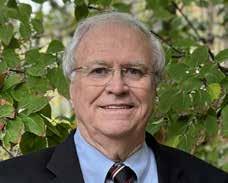
Tom Johnson served as an aide in President Lyndon Johnson’s White House and later became publisher of the Dallas Times Herald and Los Angeles Times.
porter: “Helen, UPI is ahead of us on this. It’s unclear exactly what is happening. I’ll try to provide a White House comment as quickly as we become better informed.”
The Situation Room log showed a flash message from the U.S. embassy in Tel Aviv at 2.55 a.m.
By 5 a.m., the log read: “ALL HELL BROKE LOOSE.”
This is just one of the stories that Wyatt Thomas Johnson tells in “Driven,” a memoir published Oct. 1 by the Univer-
sity of Georgia Press. The title is an apt description of the diligence and dedication that Johnson brought to every task and objective put before him.
“Driven” follows Johnson, an ambitious boy from Macon, Ga., on his journey to the University of Georgia and Harvard University, then into the first class of White House Fellows (working with press secretary Bill Moyers) and a post as special assistant to President Lyndon Baines Johnson. In the White House, he often served as notetaker during the president’s otherwise private or classified discussions.
Post-presidency, Tom Johnson — again, no relation — followed Lyndon Johnson back to Texas, where he managed the Johnson family’s media properties, before becoming publisher of the Dallas Times Herald and then the Los Angeles Times.
At age 48, he came home to Georgia as president of CNN. Johnson’s first day on the job was Aug. 1, 1990. The next day, Iraq invaded Kuwait. CNN’s coverage of the Gulf War brought the network global recognition.
Now 84 years old, Tom Johnson possesses a “golden Rolodex” and a wealth of stories covering a span of American history.
[Full disclosure: My years at CNN included Johnson’s tenure (August 1990 to June 2001). For all of the stories I have heard him tell, there was much in “Driven” that was new to me.]
“Driven” takes readers inside the White House during the Vietnam War, anti-war protests, racial tensions, the “Great Society” programs, and into major news organizations, particularly CNN, then owned by Ted Turner, with its headquarters in Atlanta.
Johnson writes in a straightforward manner about his career. If he wasn’t smarter than others, he was determined to succeed by outworking them.
He is candid about the toll that this commitment took on his family and his mental health, and the debt that he owes his wife and two children for their support.
Johnson went public (along with Atlanta business leader J.B. Fuqua) about his battles with depression in a January

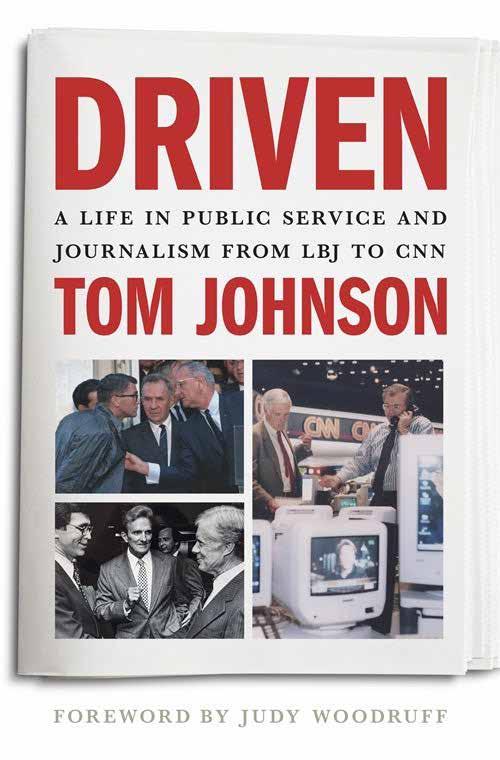
2002 interview in the Atlanta JournalConstitution. “The most important message that I want to convey is this: Depression is a treatable illness,” he writes in “Driven.” The interview “lifted a tremendous weight off my shoulders, and inspired others to share their own stories. More important, it inspired me to become more deeply involved with other major mental health projects.”
Johnson has been a major backer, through philanthropy and public advocacy, of treatment facilities and initiatives, notably Skyland Trail in Atlanta.
In the book’s foreword, journalist Judy Woodruff, whose career began in Atlanta, wrote: “He acknowledges there were times when he considered suicide, and credits his wife, Edwina, with being there, always, as a pillar of support and, literally, a life saver.”
Leading an organization such as CNN or the Los Angeles Times comes with an inherent degree of stress.
Johnson writes that in 1988, as publisher of the Times, he “was being disparaged as antisemitic because of our very independent coverage of Israeli-Palestinian issues. The Times confronted a boycott by many Jewish-led advertisers and temporarily lost thousands of subscribers.”
The vitriol prompted his son, Wyatt,
to write a letter to a Jewish newspaper in Los Angeles.
The son wrote that “my father is a wonderful, enlightened man — though perhaps not radical. I know of no prejudices he holds towards any man due to one’s creed, color or faith. He’s not going to slant anything to make any group happy. He will do anything he can to stop antisemitism, but there is also a lot of concern about racism towards other groups, Palestinian included.”
In his memoir, Johnson writes: “It is Wyatt’s letter that reminds me to this day that we did our best to provide accurate, fair, and comprehensive coverage, no matter who it angered or pleased. A quality newspaper doesn’t cater to any one group; a quality newspaper reports the news.”
Was everything at CNN always done to that standard? Johnson is forthright about the challenges and instances where he believes the network came up short and which pain him to this day.
Johnson also writes of being influenced “by some incredible people through different religious communities.” He names three, one being the late Rabbi Alvin Sugarman of The Temple. [In conversations, Johnson called Sugarman “my rabbi” and Sugarman spoke warmly of their friendship.] ì

I s y o u r e s t a t e p l a n a s l i fe l e ss a s a n o l d
c h e w to y? D o n ’t l e t y o u r a ss e t s v a n i s h
l i k e a t e n n i s b a l l u n d e r t h e co u c h!
T h i s H o w l-o w e e n, t r e a t y o u r s e l f to
p e a c e o f m i n d:
��
Wi l l s d ra f t e d w i t h p a w-fe c t
p r e c i s i o n
��
Tr u s t s t h a t a r e a s l o y a l a s y o u r
f a v o r i t e p u p
��
Po w e r s o f A t to r n e y s h a r p e r t h a n
m y b a r k a t t h e m a i l m a n
O u r bo n e-c h i l l i n g s p e c i a l: M e n t i o n t h i s
a d a n d s c h e d u l e a co n s u l t a t i o n b y
O c to b e r 31s t, a n d w e ’l l s l a s h 1 3% o f f o u r
s t a n d a rd p a c k a g e! D o n ’t w a i t u n t i l i t’ s
to o l a t e e v e n I c a n ’t c h a s e o f f t h e
G r i m Re a p e r.
Re m e m b e r, a s o l i d e s t a t e p l a n i s l i k e
g a r l i c to v a m p i r e s i t k e e p s t h e c r e e p s
a w a y a n d p ro t e c t s w h a t’ s y o u r s.
C a l l R o b e r t M. G o l d b e rg & A ss o c i a t e s to d a y a t (7 70) 2 2 9-572 9 o r v i s i t w w w.g o l d b e rg e s t a t e p l a n n i n g.co


Tom Johnson’s memoir, “Driven,” recounts his rise from Macon, Ga., to serving as an aide in President Lyndon Johnson’s administration, and later becoming president of CNN.
Eldar and Stefani Have Their ‘Base’ Covered
By Marcia Caller Jaffe
Sandy Springs recently welcomed BASE, a unique experiential studio blending a fashion-forward retail store with skin treatments in a space designed for “everyday indulgence.”
BASE, created and founded by two local women, Eldar Karen and Stefani Silverman, who left their corporate careers in the aesthetic skincare and retail fashion industries, is a lifestyle venture that caters to the needs they recognized as essential in their own busy lives — fashionable wardrobe essentials and self-care through effective skin treatments. The concept rolls out into “when you cover your base with quality, you’re left feeling confident and ready for anything.”
BASE’s open concept offers a welcoming atmosphere where fashion combined with facials cultivates a platform to refresh skin, elevate the wardrobe, and recharge the spirit. Products, treatments, and experiences are designed to elevate what could become routine in beauty regimens. Women of all ages are potential customers, but this elevated lifestyle approach is somewhat millennial driven.
Star Gwyneth Paltrow’s multi-milliondollar empire GOOP, founded in 2008, sprang from a lifestyle newsletter to now selling products centered around wellness, beauty, fashion, and intentional living as an au currant buzz word.
BASE’s similar language is designed to simplify routines and elevate everyday living. The space encourages connection, confidence, and a little indulgence — all in one curated setting.”
Some of the most popular BASE brands are American Vintage, AMO Denim, DL1981, S Carter, and Perfect White Tee. They also have athleisure, denim, tops, sweaters, skirts, dresses, jackets and two jewelry brands: S. Carter Designs and Muscat Jerusalem. Apparel prices vary between the $100 to $350 range. Best sellers are denim and pieces that elevate the staples.
Karen noted, “We spent a lot of time curating our brands and selection so that you will see many brands that are new to the Atlanta market."
Silverman explained, “BASE offers a refreshingly modern approach to selfcare: expert facials, tension-melting massages, and curated fashion finds all under one stylish roof. We aim to cater to those who want to look and feel their best without sacrificing quality, community, or convenience. We believe beauty is confidence and that it can start with a fresh glow and the perfect capsule wardrobe.”




They want the “BASE space” to be warm, inspiring, and designed for customers to linger. Karen added, “Great style is about more than clothing — it’s about how it inspires confidence and elevates your look. At BASE, we curate pieces that effortlessly elevate your wardrobe, while pairing them with skincare treatments that bring out your most confident, glowing self.”
BASE highlights include:
• Expert-Led Skincare: From hightech treatments like HydraFacial and Glo2Facial to signature techniques like caviar facials
• Massage and Wellness: Targeted massages to restore balance, relieve stress, and improve overall well-being
• Curated Fashion Retail: A rotating
selection of elevated everyday pieces, accessories, and gifts sourced from emerging and established brands
• Membership Program: Exclusive perks, event invitations, retail discounts, and custom swag for loyal clients
• Community-Focused Events: Sipand-shop evenings, skincare master classes, and trunk shows designed to bring the community together.
Hailing from Toledo, Ohio, Silverman, wife and mother of three, had a career in sales leadership with Geneo and formerly Hydrafacial and Allergan/SkinMedical. Karen grew up in the Main Line suburbs of Philadelphia. At one time, she was an educator. Married, she has four children, a dog, and five chickens.
It’s not too early to gear up for
Chanukah with gift cards, seasonal gift boxes, fancy jewelry boxes, and overall elevated packaging that is used daily.
Note that full body massages are not yet on board — just facials that all include neck and decollete (French for “bare to the neck”), as a more European style providing a luxe experience coupled with science-based treatments.
BASE is closed on Mondays. They are open from 2 to 7 p.m. on Tuesday, 10 a.m. to 6 p.m., Wednesdays through Saturdays, and 2 to 7 pm on Tuesdays, and noon to 5 p.m. on Sundays.
With free easy parking out front, BASE is located directly across from Sandy Springs Kroger at 6070 Sandy Springs Circle. For more information, please call 770-430-3092 ì
BASE wants women to have an “intentional” feeling in their curated space.
Stefani Silverman and Eldar Karen both had experience in beauty and fashion prior to opening BASE.
BASE is located directly across from the Sandy Springs Kroger at 6070 Sandy Springs Circle.
BASE is bringing some new brands to Atlanta.



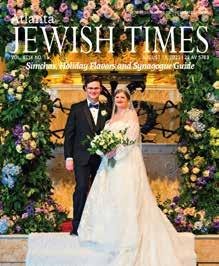






Hadar Institute Expands Locally
By Debbie Diamond
To build more vibrant, practicing, and egalitarian communities, the Hadar Institute has begun programming in Atlanta and will be led by Rabbi Ayal Robkin, a third-generation Atlantan with deep ties to the Jewish community here.
Hadar is focused on building upon what it describes as the “three pillars” of Jewish life: Torah (learning), Avodah (prayer and music), and Hesed (acts of loving kindness). These pillars are central to the organization’s mission to help individuals and communities build Jewish lives through activities like text study, communal prayer, and service projects.
Hadar Atlanta’s launch event was held recently at Congregation Shearith Israel. The participatory gathering, called “Rising Song Elul Gathering,” combined communal singing, rooted in traditional texts; contemporary melodies and harmony; and prayerful communal singing and niggunim (wordless melodies, often sung in a group setting using repetitive

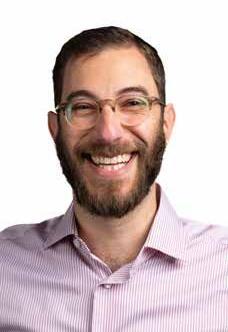
vocals like bim-bim-bam or yai-yai-yai). The event was presented in partnership with Congregation Shearith Israel and co-sponsored by Ma’alot Atlanta and

Base Atlanta.
The event was headlined by Rabbi Deborah Sacks Mintz, an accomplished musician and Hadar’s director of tefillah and music. She has collaborated on more than two dozen records of new Jewish music, including her original albums, “The Narrow and the Expanse,” (2020) and “Yetzira” (2023). Sacks Mintz was joined by local Atlanta musicians Dov Rosenblatt, Rabbi Ariel Root Wolpe, and Ori Salzburg for the concert that evening. A packed room of joyful and engaged participants, many of whom join the gatherings throughout the country, sang along with the musicians throughout the performance.
“I could not be more excited to return home to Atlanta with Hadar,” said Rabbi Ayal Robkin, director of Hadar Atlanta. “Hadar’s religious vision reflects so many values that I learned growing up here – warmth, openness, responsibility for the community and broader society. My hope is that Hadar Atlanta will be a place where people from all Jewish backgrounds can come together to learn, pray, and build community.”
Rabbi Robkin is a graduate of Greenfield Hebrew Academy (now Atlanta Jewish Academy) and The Weber School. Prior to moving back to Atlanta, he taught Talmud, Bible, Jewish thought, and mindfulness meditation at the Abraham Joshua Heschel High School in New York. A graduate of University of Maryland with a master’s degree from the University of Pennsylvania, he is also a graduate of the Pardes Educators Program and holds rabbinic ordination from Yashrut.
Hadar Atlanta launched this local effort as a result of a generous, multi-year commitment of $1.1 million from the Zalik Foundation. This support reflects the Foundation’s commitment to strengthening Jewish education in Atlanta by investing in meaningful, high-quality learning opportunities that connect Jewish values and wisdom to everyday life.
“As Atlanta and its Jewish community have grown, so has the demand for meaningful learning and spiritual depth,” said Rabbi Avi Killip, executive vice president of Hadar and a fellow Atlanta native. “We are showing up where Jews are, responding to their needs, and enriching the already vibrant Jewish landscape in the area.”
Hadar Atlanta is a significant, new investment for the organization, which also has full-time faculty positions in New York, Jerusalem, Boston, Chicago, Washington, D.C., and Los Angeles. Nationally, Hadar engages more than 35,000 people each year through both classes and multi-day, immersive learning opportunities, concerts and events. Hadar also offers content via its online library, podcasts, publications and other resources.
Rabbi Robkin is joined in Atlanta by his wife, Maddy Bloch, and children, Neima and Menashe. He is currently meeting with individuals and organizational leaders to assess the needs and types of programming desired in Atlanta. To find out more about the events offered by Hadar Atlanta, please email info@hadar. org and ask to be added to its listserv in Atlanta. ì
Rabbi Ayal Robkin
Rabbi Deborah Sacks Mintz leads the musicians and participants at the Rising Song Elul Gathering.
Grand Tasting Midtown Enjoys Another Banner Year


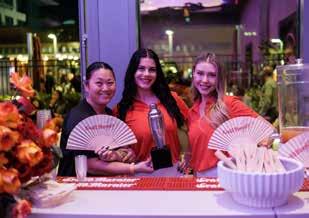
By Debbie Diamond
In her delightful, unassuming manner, Taste of Atlanta founder Dale DeSena greeted old friends and new visitors as they mingled throughout the Grand Tasting Midtown, held on Oct. 17, at Epicurean Atlanta, a Marriott Autograph Collection hotel located in the culinary epicenter of midtown Atlanta.
With tickets completely sold out in advance of the event, Grand Tasting Midtown was spread through the
that Nurtures

For those with a sweet tooth, several delectable desserts were shared. Scrumptious cake bites, brownies and strawberries waited to be dipped in chocolate from the Melting Pot. A variety of delicious doughnuts from Sublime, cake slices from Atlantans’ favorite cakes at Publix, and award-winning mini cupcakes from Cupcakin’ Bake Shop helped create a stellar offering of desserts at this year’s tasting. A mix of craft cocktails also flowed from sponsors such as Tito’s, Absolut, Aplomo Tequila, Grand Marnier, Primero Tequila, and St. Julian Winery at booths scattered throughout the event. In addition, for non-drinkers, Smart Water and Coke Zero cans were on hand for those desiring a less potent option.
The beautiful night helped set the stage for a perfect evening under the stars for the many attendees, who were clearly enjoying themselves with the unlimited food offerings and cocktails. Laughter and conversation were in the air, and the festive mood was enhanced by songs from Ethel Shotter, who has toured the world with such notables as Beyonce and Robin Thicke. Her soulful voice and lively band kept many guests on their feet for much of the night.
Guests also had an opportunity to register for a free trip to Jamaica through Delta Vacations and Visit Jamaica. And if anyone needed their diamond ring brightened, staff members from Solomon Brothers Jewelers were busy polishing any baubles offered up by guests. The sponsor list was wide and varied, including not only food and beverage companies, but also a notable list of
Atlanta mainstays such as Emory University Hospital Midtown, Audi Atlanta, and Society Insurance.
The highlight of any tasting event is when the awards are announced. Voting was done by attendees in three categories. The winner of the 2025 Best Taste Award went to Chicheria Mexican Kitchen at The Works ATL in West Midtown for their Sweet Corn Esquites, made with roasted corn, chipotle crema, queso fresco, and lime. Best Dessert was awarded to Cupcakin’ Bake Shop for their assortment of peach cobbler, key lime pie, red velvet, and vanilla salted caramel cupcakes, and Best Beverage was won by Grand Marnier for their Grand
Peach Margarita.
Coming up on her 25th anniversary next year as the creator of Taste of Atlanta, DeSena was elated about this year’s Grand Tasting Midtown event. “What an awesome night with delicious bites from some of the best restaurants in Midtown, along with the beer, wine, and craft cocktail tastings. The weather, crowd and live music were all first class, and we are so proud to showcase this Atlanta talent! We are planning some special additions for 2026 to celebrate our silver anniversary,” said DeSena as she shared her thoughts on the evening’s festivities. ì
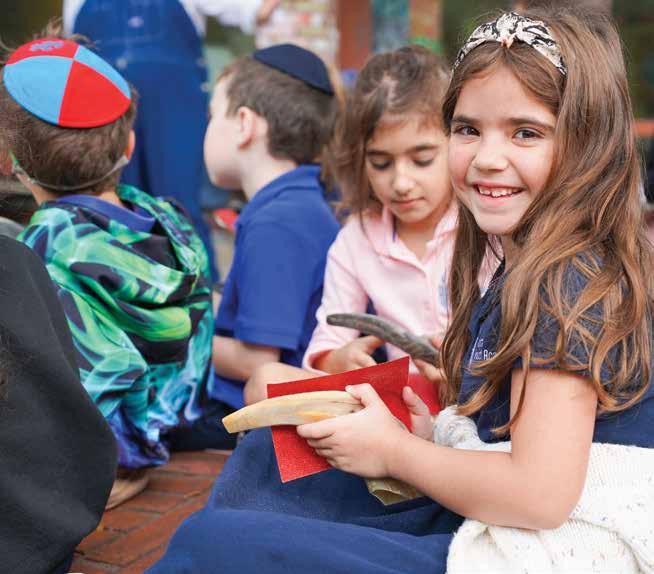
Chicheria Mexican Kitchen proudly displays the grand fork to mark their win in Best Tasting category.
Cupcakin’ Bake Shop won the silver wisk for Best Dessert. Grand Marnier took home the silver shaker for Best Beverage.
Murray set to Present at JCC BookFest
By Marcia Caller Jaffe
Journalist Douglas Murray poses, “When faced with a choice between supporting a democracy like Israel or a death-cult like Hamas, why did so many people in our societies choose the deathcult? The answer to that poses a challenge not only to Israel but to the rest of us.”
Label him provocative, sharp-witted, polemical, and incisive: then call him one of “Israel’s best friends.”
British journalist, essayist, public intellectual, and political analyst Douglas Murray will appear at the Book Festival of the MJCCA at 8 p.m., Saturday night, Nov. 15. Through the sponsorship of philanthropist and minority owner of the Atlanta Falcons, Ed Mendel, Murray will present his book, “On Democracies and Death-Cults: Israel and the Future of Civilization,” in conversation with Atlanta Journal-Constitution journalist Greg Bluestein.
Mendel stated, “There’s only one Doug Murray; and he’s remarkable on so many different levels. Israel and the Jews have had no better friend for a long time.”
Murray added, “I admire my Jewish friends and acquaintances who have used the horror of the last two years to become more engaged with their faith, culture and tradition. It’s one of the few positive things to come out of recent times.”
In an interview with the AJT on Sept. 29, Murray, a non-Jew, revealed the following:
Jaffe: What’s the real takeaway from the book?
Murray: “On Democracies and Death-Cults” is an account of the Oct. 7
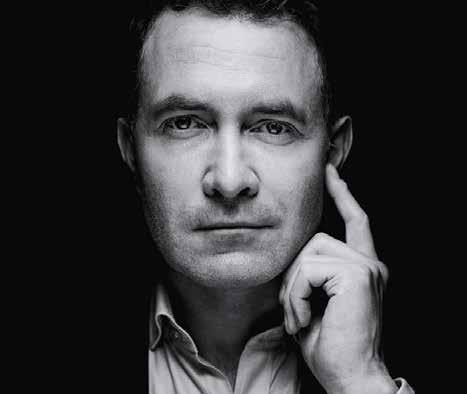

Journalist Douglas Murray sees the trajectory of secular Jews noticing the backlash since Oct. 7, as “broadly
atrocities and the war that resulted from that terrible day. It draws on my firsthand reporting from the scenes of the massacres and my subsequent time spent over the past two years reporting from Gaza, Lebanon and other parts of the conflict. The second main aspect of the book is a broader reflection on why the rest of the civilized world went mad in response to Oct. 7. Why was it that from the day itself major protests broke out in every Western country not in support of the people who had been massacred but in support of the people who did the massacres? Why did support for Hamas turbocharge everywhere in our societies, from
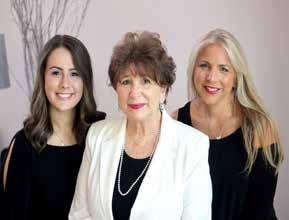

elite institutions like universities and elected representatives to street protests, online platforms and more?
Jaffe: Has Charlie Kirk’s murder changed your security detail and the topics you’re addressing?
Murray: I never talk about my own security arrangements. But no, it has not changed the way I live and certainly not the topics I address. I liked and admired Charlie and his murder is a terrible tragedy, firstly for his family, but secondly for American democracy as a whole. But I have encountered the assassin's veto before in my life and career, and my views remain. When people try to silence opinions at the barrel of a gun, you only have two choices as individuals and as a society: silence yourself or keep going (and indeed even speak out more). I choose the latter … and encourage everyone else to do the same.
Jaffe: What outcomes do you see for the Gaza war?
Murray: President Trump's peace plan has only just been announced and at the time of speaking we'll see if Hamas accepts it. The deal is a more generous deal than Hamas deserves, and I’m exceptionally nervous about convicted Palestinian terrorists being released from Israeli jails as part of the deal. We will see if Trump's overall plan works. The best outcome would be a totally new arrangement in Gaza and not simply a return to the post-
Murray’s book examines why so many chose to support Hamas over a democracy.
2005 status quo (that is endless rocket fire and attacks on Israel, followed by wars every few years). I would like to see the paradigm change completely. After the hostages are returned and the war is over, I would hope to see the Abraham Accords extended to other Arab countries. I hope that the Iranian Revolutionary Government is deterred for the foreseeable future. As for a final agreement end to the Israeli-Palestinian dispute, (especially the two-state solution) I’m doubtful. There are plenty of long, insoluble conflicts. This may simply be one of them.
Jaffe: Do you think liberal Jews will continue in their same trajectory?
Murray: Its not for me to say. But as a non-Jew, my advice would be to ignore the fringe extremists and not elevate their significance. There will always be Naturei Karta types. Now there is a sort of radical-left version of them, of the kind that only a few years ago said Kaddish in Parliament Square, London, for Hamas terrorists. We might call these people “Trans Jews for Hamas.” A movement that will not thrive for long. More important are the large number of totally mainstream left- and right-wing Jews, often secular, who have noticed the backlash against the Jewish state and Jewish people in general since Oct. 7. I think these people are on an inevitable trajectory. And it seems to me to be a trajectory that is broadly good. ì
World-Renowned Rabbi to Speak at BookFest
By Marcia Caller Jaffe
Described as “joyful and inspirational,” one of the country’s most unique and influential rabbis will take center stage at the Book Festival of the MJCCA at 7:30 p.m., Sunday, Nov. 9. Tied to the annual Esther Levine Read, Rabbi Angela Buchdahl will be interviewed by The Temple’s Senior Rabbi Peter Berg to share her story and memoir, “Heart of a Stranger: An Unlikely Rabbi’s Story of Faith, Identity, and Belonging.”
“Unlikely” because Rabbi Buchdahl was born in Seoul, Korea, the daughter of a Buddhist mother and Jewish American father. In conversation with the AJT and in addressing this duality, Rabbi Buchdahl said, “My mother is 83 and still a Buddhist, but she’s also an engaged and knowledgeable adjacent member of the Jewish community. I don’t have specific Buddhist practices, but I know that some of the philosophy and ways of seeing the world have influenced how I understand spirituality. I don’t see a conflict between my Judaism and the Buddhist philosophies of non-attachment and understanding suffering.”
As proof of her “secret sauce,” Rabbi Buchdahl’s congregation, Central Synagogue in New York City, has 3,500 households, plus another 1,000 in The Neighborhood. They estimate about one million viewers Zoomed in for the High Holidays on livestream. She is the first female senior rabbi there in its 185-year history. She has led prayers in the White House for two presidents and has been featured in the Wall Street Journal, NPR and Today. She lives in New York City with her husband and three children.
Buchdahl lists the five best takeaways from the book:
1: Having the heart of a stranger — while at times lonely or uncomfortable — has been the source of our superpower as a Jewish community: the foundation of our empathy, resilience, grit, and creativity.
2: Sometimes you have to leave home in order to find your truest one.
3: When I broke the (stained) glass ceiling, I stood on the shoulders of all the women who came before me.
4: You might think you’re the only one who doesn’t fit in or feels like an outsider, but every one of us is navigating multiple identities — and this knowledge can be the source of our connection, not our division.
5: We might like to surround ourselves with people who think like us, but nature loves a diverse ecosystem, and we
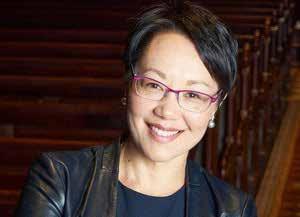

can grow most when we venture beyond our monoculture.
To complete the book over four years, she wrote in short spurts with Abigail Pogrebin, an author, editor, and friend, as a collaborator on the book. Rabbi Buchdahl cites the most difficult part to write as “I don’t have diaries from childhood, so I had to rely on memory for my early years. Some of the more painful chapters — like the violent death of my first cousin — were tucked away, and it was hard to pull up those memories and write about them.”
When asked to relate one fun thing folks might not know about her, the rabbi replied, “When I get excited about something — whether it’s a new restaurant, kitchen appliance, book, or show — I want to make sure everyone I care about knows about it and gets to enjoy it. My children’s nickname for me is “Televangela,” because I’ll campaign hard for the things I love. You could say that being a rabbi is being a campaigner for the Jewish people and for faith — which I hope comes through in this book.”
Rabbi Berg told the AJT, “I have known Rabbi Buchdahl as a colleague and friend for 25 years. I’m really excited to be in conversation with her at the Book Festival and for the world to read her book. I read a preview of the book. It’s outstanding and deeply meaningful. Rabbi Buchdahl relates how she became the first Asian American to be ordained as a rabbi. It wasn’t an easy journey … as she started feeling like an outsider to the Jewish community. Now, she is one of the most
admired religious leaders in the entire world. Our community is going to love interacting with her and hearing her story.”
Proceeds of book sales go to the In-
ternational Rescue Committee. Tickets are $20 for MJCCA members, $25 for community, and $42 for one ticket and copy of the book. ì

Rabbi Buchdahl will appear with Rabbi Peter Berg to share her passion in writing her book.
Rabbi Angela Buchdahl is the first female rabbi in her synagogue’s 185-year history.


U.S.
J.D.
Vice President Vance Visits Israel
U.S. Vice President J.D. Vance arrived in Israel last week to advance ef-
Today in Israeli History
Oct. 31, 1924: Rabbi Yehuda Amital is born in Romania. A survivor of a Nazi labor camp, he establishes Yeshivat Har Etzion as a less doctrinaire school and launches the Meimad movement as an alternative to the National Religious Party.

Minister Levi Eshkol
the
1965. // By
Nov. 1, 1965: Prime Minister Levi Eshkol, David Ben-Gurion’s chosen successor but then his political rival, retains his office when the Alignment, a merger of Eshkol’s Mapai and Ahdut Ha’Avoda, wins 45 seats in the sixth Knesset.
Nov. 2, 1917: A letter from Foreign Secretary Arthur Balfour reveals the British government’s endorsement of “the establishment in Palestine of a Jewish national home.” The wording is included in the Mandate for Palestine in 1922.
NEWS FROM OUR JEWISH HOME ISRAEL PRIDE
forts to uphold the Gaza ceasefire, amid U.S. concerns that the fragile truce could collapse. Accompanied by Second Lady Usha Vance, he was welcomed at Ben Gurion Airport by Justice Minister Yariv Levin, Israel’s envoy Yechiel Leiter, and U.S. Ambassador Mike Huckabee.
Vance met with White House envoy Steve Witkoff and adviser Jared Kushner before visiting Kiryat Gat, where a new international task force is being formed to oversee the ceasefire. He also held a press conference in Jerusalem and met with Prime Minister Benjamin Netanyahu and President Isaac Herzog.
Compiled by AJT Staff
Nov. 3, 1878: Religious Jews determined to start an agricultural settlement leave Jerusalem and establish Petah Tikvah (“Gateway of Hope”). They purchase 3,400 dunams (840 acres) from a Greek owner near the Yarkon River.
Nov. 4, 1995: Yigal Amir, a law student opposed to the Oslo peace process, fatally shoots Israeli Prime Minister Yitzhak Rabin after a peace rally in Tel Aviv. Rabin, a native of pre-state Palestine, was the fifth prime minister.
Nov. 5, 1933: Judah Magnes, the president of the Hebrew University of Jerusalem, opens the academic year by outlining a plan for the university’s expansion, including the hiring of 14 professors ousted in Nazi Germany.

Zohar Argov performs during the Oriental Song Festival in Ramle in 1985. // By Nati Harink, Israeli Government Press Office, CC BY-SA 3.0
Nov. 6, 1987: Zohar Argov, who as one of Israel’s first Mizrahi music stars is known as the “The King” but is haunted by drug addiction, accidentally dies by hanging in jail at 32 shortly after being accused of attempted rape.

// Photo Credit: Angela Weiss/Pool via AP
Israeli American Awarded Nobel Prize in Economics
Israeli American economist Joel Mokyr was named as one of a trio of researchers awarded the Nobel Prize in
Nov. 7, 1878: Avraham Yeshayahu Karelitz, the Chazon Ish, one of the 20th century’s greatest Talmud scholars, is born in what is now Belarus. After making aliyah in 1933, he helps build a strong Haredi community in Israel.
Nov. 8, 1936: Maccabi Tel Aviv completes an 11-match soccer tour of the United States with a 4-1 loss to an American all-star team at Yankee Stadium. The tour raises money for Polish Jewry and for sports in the Yishuv in Palestine.
Nov. 9, 1952: Chaim Weizmann, the first president of Israel, dies at his Rehovot home after a yearlong illness. Born in Poland, he moved to England in 1904 and developed friendships that helped win the Balfour Declaration.

U.S. Ambassador Daniel Patrick Moynihan (left), shown in 1976, responded to Resolution 3379 by saying, “The lie is that Zionism is a form of racism. The overwhelmingly clear truth is that it is not.” // By Bernard Gotfryd, Pictorial Parade, Bernard Gotfryd Photograph Collection, Library of Congress
Nov. 10, 1975: The U.N. General Assembly passes Resolution 3379, defining Zionism as a form of racism and racial discrimination, on a vote of 72-35 with 32 abstentions. Decried by the United States, the resolution is revoked in 1991.
Nov. 11, 1902: Yisrael Amir is born in Vilna in the Russian Empire. He makes aliyah in 1923 and rises through the Haganah. David Ben-Gurion names him the first Israeli Air Force commander in May 1948 though he has no aviation experience.
economics for “having explained innovation-driven economic growth.”
Mokyr, 79, a professor from Northwestern University, won alongside Philippe Aghion from the College de France and the London School of Economics, and Peter Howitt from Brown University. Mokyr’s academic studies and research specialize in the economic history of Europe, the understanding of the economic and intellectual roots of technological progress, and population change.
The Nobel committee awarded Mokyr “for having identified the prerequisites for sustained growth through technological progress.”
Compiled by AJT Staff
Nov. 12, 2000: Leah Rabin, a peace activist since the assassination of her husband, Prime Minister Yitzhak Rabin, dies at 72 a few days after a mild heart attack. She was born in Konigsberg, Germany, and made aliyah as a child.

Nov. 13, 1893: Acclaimed Israeli painter Reuven Rubin is born in Galatz, Romania. He sells his bicycle in 1912 to afford to travel to Jerusalem and enroll in the Bezalel School of Arts and Crafts. He also studies in Paris.
Nov. 14, 2012: Ahmed Jabbari, the Hamas military chief, is killed in an IDF airstrike on Gaza that marks the start of Operation Pillar of Defense, which aims to destroy rocket launchers persistently firing on southern Israel.
Items are provided by the Center for Israel Education (israeled.org), where you can find more details.

Vice President
Vance and Second Lady Usha Vance arrive in Israel.
A Nobel medal is displayed during a ceremony in New York on Dec. 8, 2020
Prime
casts his ballot in
Knesset election Nov. 1,
Moshe Pridan, Israeli Government Press Office, CC BY-SA 3.0
Reuven Rubin paints a portrait of his son in 1951. // By Yair Talmor
Marcus Blood Center was Vital After Hamas Attacks
By Ronit Franco-Pinsky
During a recent visit home, this writer had the privilege of touring the Marcus National Blood Services Center in Israel — a facility that stands as a beacon of preparedness, resilience, and hope. Officially inaugurated on May 2, 2022, the center was made possible through the generous donation of Billi and Bernie Marcus. The project took four years to complete, with a total cost exceeding $135 million. Of that, $25 million was donated directly by the Marcus family, and an additional $10 million grant was provided by the Marcus Foundation.
The Marcus Blood Services Center is a state-of-the-art facility spanning more than 550,000 square feet. It is the only blood center in the world designed to withstand missiles, chemical, and biological attacks — a truly remarkable and vital achievement.
Long before the tragic events of Oct. 7, 2023, Bernie Marcus foresaw Israel’s need for a secure, resilient blood facility — one capable of operating under any condition, whether war, disaster, or attack. His vision proved predictive: during the Oct. 7 war with the terror group Hamas, and again on June 12, 2025, when Iran launched a large-scale missile assault on Israel, the Marcus Center remained fully operational and completely undamaged.
The Blood Center, operated by Magen David Adom (MDA), supplies up to 1,200 units of blood daily. In the aftermath of Oct. 7, these units became a literal lifeline, saving countless lives. During the early weeks of the war, the Israel Defense Forces relied heavily on blood transfusions supplied directly from the MDA and Marcus Center to treat soldiers on the front lines.
At the heart of the facility lies its underground vault — the most secure and sacred part of the complex. Here, blood units are received, tested, processed, and stored. The staff refer to this inventory as “liquid gold.”
During a tour, Moshe Noyovich, a senior MDA representative and project leader, guided this writer’s group deep underground to witness the meticulous preparation, sorting, and distribution of blood units. It was a fascinating and deeply moving experience.
Blood collected at the center is separated into three essential components: red blood cells, stored by type; plasma, the yellow fluid, kept frozen at minus 30 degrees Celsius to preserve its integrity; and platelets, used for clotting and emergency care.

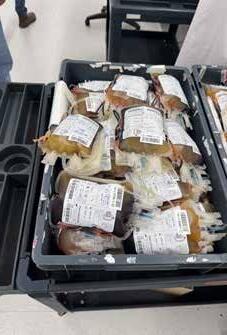

Blood collected at the center is separated into three essential components: red blood cells, stored by type; plasma, the yellow fluid; and platelets.
Months before Oct. 7, MDA had already sensed growing tension and increased its fundraising efforts through the Friends of MDA, expanding production capacity and staffing levels. This foresight proved lifesaving. When the war broke out, the center shifted instantly into emergency mode. Its pressure systems were activated, and blood mobiles were deployed across Israel to deliver units to hospitals, IDF field clinics, and emergency stations. Thirty-five MDA ambulance centers were mobilized, ensuring that every wounded soldier and civilian received immediate care. MDA teams set up improvised treatment sites at MDA stations, road junctions, and even in their living rooms. The emergency dispatch center’s staff answered thousands of calls and offered immediate assistance,
Following Oct. 7, an additional wing was rapidly constructed to enhance wartime response capabilities. Hundreds of operators and medical professionals worked around the clock and the facility became a symbol of national endurance during one of the longest wars in Israel’s history.
The building also functions as a massive safe room, or in Hebrew, mamad, providing shelter for staff and civilians during missile alerts. The underground vault is equipped with extra blast protection, capable of withstanding even the most powerful attacks.
In 2025, the center also opened Israel’s first full-time paramedic training school, complete with modern class-
rooms, simulation labs, and an auditorium — ensuring that the next generation of emergency responders is well prepared.
Among the center’s many innovations, Mother’s Milk Bank left the deepest impression on this writer. This unit collects and stores donated breast milk for infants whose mothers cannot provide it. During and after Oct. 7, more than 30 babies were left without access to their mothers’ milk — some because their mothers were killed, kidnapped, or
Each star on this wall represents someone who donated to the Mother’s Milk Bank, which helped provide nourishment to more than 30 babies whose mothers were unable to provide for them.
called up for IDF reserve duty. In partnership with Israel’s HMOs and hospitals, the Marcus Center provided these infants with life-sustaining nourishment, offering comfort and survival amid chaos.
The Marcus National Blood Services Center continues to expand. Future plans include a central ambulance commander hub, another paramedic training institute, and a new emergency operations wing. The Marcus Center is a living symbol of resilience, generosity, and the unbreakable spirit of the Israeli people. ì
IS ELI HOSTAGE T CKER
The following is an index of Israeli hostages with the most current information available as of press deadline.
The first phase of Israeli hostage transfers is complete. The Atlanta Jewish Times will update this hostage tracker with current news of the next round of hostage transfers. Bring Them Home.
Israeli hostages remaining:
Thirteen hostages are either believed to be dead or their deaths have been confirmed:
Amiram Cooper, 84 (murdered in captivity)
Asaf Hamami, 41 (murdered in captivity)
Oz Daniel, 19 (murdered in captivity)
Ran Gvili, 24 (murdered in captivity)
Sahar Baruch, 35 (murdered in captivity)
Itay Chen, 19 (murdered in captivity)
Dror Or, 48 (murdered in captivity)
Joshua Loitu Mollel, 21 (murdered in captivity)
Idan Shitvi, 28 (murdered on Oct. 7, 2023)
Lior Rudaeff, 61 (murdered in captivity)
Meny Godard, 73 (murdered in captivity)
Hadar Goldin, 23 (murdered in 2014)
Sudthisak Rinthalak (murdered in captivity)
Ronit Franco-Pinsky is pictured outside of the Marcus National Blood Services Center, which was instrumental in treating victims of the Oct. 7 attacks.
SPORTS
Israel Gymnastics Banned from World Championships
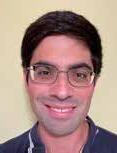
David Ostrowsky
For months, the Israeli gymnastics team, headlined by 2020 Olympic gold medalist and defending men’s floor exercise world champion Artem Dolgopyat, had been expecting to participate in the 53rd FIG Artistic Gymnastics World Championships in Jakarta. Even though Indonesia is the world’s most populous Muslim-majority country, one that has long supported Palestinians and prohibited Israeli athletic delegations from competing on its soil, the Israeli Gymnastics Federation claimed that it had been assured by Indonesian officials this summer that the Israeli team could compete in last week’s world championship.
However, in early October, in light of the war in Gaza, Indonesia reversed course and announced it was denying visas to Israeli gymnasts planning to travel to Jakarta. Subsequently, Israel had no representation at the gymnastic world championships.
Despite the recent Israel-Hamas ceasefire, Israel’s planned arrival in Jakarta continued to trigger intense opposition among some Indonesians. Ultimately, their vociferous protests did not fall on deaf ears as earlier this month, Indonesia’s senior minister of law, Yusril Ihza Mahendra, officially declared that the Israeli team would be forbidden from entering the country, while adding in a video statement that the decision aligned with Indonesian President Prabowo Subianto’s prior directives on various occasions and his speech at the UN General Assembly, which chastised Israel for its actions on the Gaza Strip. (Mahendra did acknowledge that the Indonesian Gymnastics Federation had previously submitted a sponsorship letter for six Israeli athletes to secure visas, but that “the federation has withdrawn the sponsorship letter.”)
In response to the denial of visas, the Israeli Gymnastics Federation swiftly appealed to the Court of Arbitration for Sport (CAS), mandating that it either guarantee Israel’s participation or enforce a move or cancellation of the world championships. CAS did not view the appeal favorably, ultimately denying Israel’s petition on the grounds that the International Gymnastic Federation (FIG) had no authority to intervene in Indone-

sia’s visa policies.
On behalf of its gymnasts deprived of the opportunity to perform on the world’s grandest stage, the Israeli Gymnastics Federation (IGF) unleashed a torrent of criticism at the decisions rendered.
“The rules are clear, and Indonesia’s actions constitute a blatant violation of them. It is inconceivable that a country can bar another nation from competing in a World Championship while the governing bodies stand by,” the IGF official statement read. “This decision undermines the very foundations of sport and fair competition, and it delivers a severe blow to the morale of the gymnasts and staff who have worked tirelessly for this moment.”
IGF General Secretary Sarit Shenar went on to tell Reuters, “For this world championship, this is the end of the road. So, we cannot, no matter what will happen for the gymnast, we cannot fix their hearts.”
Once it became apparent that Israel would be barred entry, the International Olympic Committee (IOC), the global, non-governmental, sports governing body of the Olympic Games, initially acknowledged having “great concern” and pledged to “discuss the specific situation”
at its next Executive Board meeting.
The IOC went on to say, “The IOC’s principled position is very clear: all eligible athletes, teams, and sports officials must be able to participate in international sports competitions and events without any form of discrimination from the host country.
“It is therefore the direct responsibility of the host country, the organizer, and the sports organizations directly concerned to make sure that this principle is fully respected.
“Sport must remain a safe space for athletes to fulfill their dreams; and athletes must not be held responsible for political decisions.”
Just last week, the IOC made good on its word by dropping the hammer on Indonesia, calling for international sports federations to stop holding events, tournaments, and conferences in the country until policies are changed. The IOC took the punishment a step further, announcing that it was cutting off “any form of dialogue” with Indonesia regarding hosting future Olympic events until the Indonesian government provided “adequate guarantees” that all athletes would be granted access to the nation irrespective of nationality. This decision is particularly notable given that Indonesia is on the
short list of countries, along with India and Qatar, that are in the running for a bid to host the 2036 Summer Olympics, following the 2028 Games in Los Angeles and 2032 Games in Brisbane, Australia.
Following the IOC’s declaration, Indonesia’s Youth and Sport Minister Erick Thohir acknowledged that his country’s government understood its decision to bar entry of the Israeli gymnasts would have serious repercussions. Meanwhile, the Indonesian Olympic Committee has been invited to IOC headquarters in Lausanne, Switzerland, to further discuss the matter.
Indonesia’s recent decision, while sparking significant global backlash, is not without precedent. In 2023, Indonesia was disallowed from hosting the Under-20 Men’s World Cup by FIFA after Bali’s governor refused to host the Israeli team amid nationwide calls for Israel to be banned. Even going back to last century, the Southeast Asian country has proven to not be particularly hospitable to Israeli athletes: in 1958, Indonesia joined Turkey and Sudan in removing itself from the World Cup qualifiers so it didn’t have to compete against Israel; four years later, during the 1962 Asian Games, the Indonesian government neglected to provide visas to Israeli participants, compelling Israel to drop out. ì
Israeli Olympian Artem Dolgopyat is one of the world’s greatest floor exercise gymnasts, but unfortunately, he and the rest of Israel’s gymnastics team were barred entry from last week’s Artistic Gymnastics World Championships in Jakarta, Indonesia // Photo Credit: Team Israel social media
World Series Matchup Features Jewish Storylines
By David Ostrowsky
The 2025 World Series, pitting the Los Angeles Dodgers against the Toronto Blue Jays, doesn’t feature any Jewish players, coaches, or managers. That said, quite a few intriguing Jewish storylines pervade this year’s Fall Classic as evidenced by the following angles:
-- Andrew Friedman, Stan Kasten, and Lon Rosen
The Dodgers are gunning for their second consecutive World Series title, a feat that has become increasingly difficult with the expanded playoff format and hasn’t been accomplished since the New York Yankees were crowned champs three years in a row (1998 to 2000). But the Dodgers’ success spans well beyond the back-to-back World Series appearances as the club hasn’t missed the postseason since 2012. President of Baseball Operations Andrew Friedman, President/CEO Stan Kasten, and Executive Vice President & Chief Marketing Officer Lon Rosen have been spearheading the front office for virtually that entire time frame.
Prior to Game 1 of the National League Championship Series, in which the Dodgers swept the Milwaukee Brewers in four games, Friedman was asked about the past year’s journey towards securing that elusive second straight title.
“I haven’t really had a chance to kind of think through the ‘25 season — living it day-to-day but not really being able to rise above it to really assess,” Friedman offered. “Living it, there were definitely challenging moments.”
The Dodgers, who did, in fact, grind through an underwhelming 93-69 regular season, have been able to spend unprecedented amounts of money on free agents over the past few winters. However, Guggenheim Baseball Management’s (the ownership group of the Dodgers) unlimited resources translating into annual deep postseason runs is a dynamic that some fans have decried recently — and one that Friedman addressed during his World Series media availability.
“Yeah, I mean, for us, it is all about our incredible fans and us giving back … so, you know, that’s our focus. So, anything else that comes from it — and obviously, I’ve heard a lot of it — it’s just not front of mind for us because everything is around how do we put ourselves in the best position to win now and also to win in the future.”

Whereas the Dodgers have established themselves as the team of the 2020s, the gold standard of Major League Baseball, the Blue Jays are coming off a last-place finish in 2024. But Canada’s only Major League franchise, one that coming into this year hadn’t won a playoff game this decade, has authored a stunning season-to-season turnaround in reaching its first World Series since 1993. As Blue Jays President & CEO, Mark Shapiro has not only presided over the roster overhaul to position the club for this unexpected postseason run but has also been heavily involved with business operations, partnering with ownership to execute massive renovations to the Jays’ regular-season home, the Rogers Centre, and player development complex in Dunedin, Fla.
Speaking to the media back in August, Shapiro remarked: “We’ve established our brand of baseball that is rooted and founded in the toughness and the cohesiveness of our players … I find a lot of joy in watching this team play because of the way they play,” said Shapiro. “I appreciate tough at-bats. Love that style of baseball.”
Following this season, Shapiro’s future in Toronto remains shrouded in mystery as he’s in his final contract
year. A longtime executive for the franchise formerly known as the Cleveland Indians, Shapiro has been in Toronto for a decade now and has stated he wants to remain with the Jays, but has yet to share specifics on extension talks
-- Sandy Koufax
When fans stream into Dodger Stadium for the middle games of the World Series this week, many will pass by the Sandy Koufax statue standing tall outside the centerfield plaza entrance. The all-time most celebrated Jewish pitcher who’s widely considered to be the greatest lefty in baseball history, Koufax spent his entire 12-year career with the Brooklyn/Los Angeles Dodgers and in many ways remains the face of the franchise. This month also represents the 60-year anniversary of Koufax’s magical October 1965 run when the Hall of Famer yielded a single run over three World Series starts.
-- Shawn Green
Shawn Green, a two-time All-Star with more than 2,000 career hits, retired in 2007 as one of the all-time most prolific Jewish sluggers. His prime years (1998 to 2002), during which he was the face of Jewish baseball, were split between both of this year’s World Series participants. As a Dodger in May 2002, Green
became only the 14th Major Leaguer to club four homers in one game.
-- Andrés Giménez
The Blue Jays acquired Andrés Giménez, the sure-handed second baseman who’s been a surprising offensive sparkplug this October, from the Cleveland Guardians in a multi-player trade involving infielder Spencer Horwitz during last year’s Winter Meetings. A few hours later, Horwitz was flipped to the Pittsburgh Pirates, for whom he had a career year in 2025.
-- Dan and Ben Shulman
For many sports fans, Dan Shulman is a household name as before becoming the Sportsnet television voice of the Blue Jays, he was a fixture on ESPN’s baseball coverage, calling a dozen World Series for ESPN Radio and serving as the play-byplay man for ESPN’s “Sunday Night Baseball” from 2011 to 2017. The elder Shulman’s also a finalist for the 2026 Ford C. Frick Award, given to one baseball broadcaster every year by the National Baseball Hall of Fame and Museum. A few booths down at the Rogers Centre, Dan’s son, Ben Shulman, the 25-year-old lead radio voice of the Jays, is one of the youngest broadcasters calling games for a North American major pro sports franchise. ì
This predominant narrative surrounding this year’s Fall Classic may be Canada’s team (Blue Jays) going up against a team with a prominent Japanese presence (Dodgers), but the Series also has quite a few Jewish angles // Photo Credit: Toronto Blue Jays social media
-- Mark Shapiro
SOJOURN to Host Rainbow Youth Summit on Nov. 11 Lenhard Opens Concierge Medical Practice

On Nov. 11, SOJOURN will host the Jewish Professionals for Rainbow Youth Summit (JPRY). This summit is intended for professionals who work with youth in a Jewish setting. JPRY will highlight the ways that teachers and youth-facing staff can create supportive environments and respond to the needs of LGBTQ+ youth in their Jewish communities, with a focus on those working with trans and non-binary youth.
This gathering is a call to action for Jewish professionals — rabbis, educators, therapists, youth workers, and communal leaders — to show up with courage and compassion for queer Jewish youth. Rooted in the sacred principle of pikuach nefesh — the obligation to preserve life — this conference centers the voices and needs of LGBTQ+ Jewish young people and equips professionals to be their fierc-

est allies and advocates. SOJOURN is proud to be partnering with JTeen of Jewish Federation of Greater Atlanta, Jewish Women’s Fund of Atlanta, and Community Corps to make this event happen.
The summit will take place from 9:30 a.m. to 4 p.m., in Sandy Springs. Further location details will be sent to participants once they register. SOJOURN is requesting each organization or team send three participants to the summit –SOJOURN does not want any one (or two) people being solely responsible for implementing new learnings in their organization. There is no cost to attend JPRY. Registration can be found at https://tinyurl. com/jpry11-11 and will end at noon on Thursday, Nov. 6.
Compiled by AJT Staff



By Marcia Caller Jaffe
After three decades practicing as an Atlanta-area internist within corporate health systems, Dr. Steven Lenhard has embraced a new model of care that he hopes will restore focus on patients and combat physician burnout by co-founding Premier Concierge Care of Atlanta (PCCA) in Vinings.
Dr. Lenhard’s move reflects a broader trend in medicine where both doctors and patients are seeking alternatives to a system that can prioritize quantity over quality. For years, Dr. Lenhard found himself struggling with the overwhelming patient volume expected of internists at large medical corporations with pressure that took a heavy toll on his sense of duty to his patients. His census of patients has gone from 4,500 in the large system to less than 500.
Dr. Lenhard explained, “My partner and I decided to build a practice from the ground up where we could get back to nurturing long lasting, personal relationships with our patients. Because we have fewer patients as a whole, I can spend as
much time as necessary working with individuals to manage or solve medical issues, either in the office or virtually.”
After patients pay an enrollment fee of less than $200 a month, most PCCA treatments and tests are covered by insurance, including Medicare.
“The difference is, the patient and I are in charge of deciding the best course of action, not a large corporation that relies on volume of patients,” Dr. Lenhard added.
Other benefits of joining PCCA include extended office visits, same-day appointments, ease of scheduling annual physicals, and 24/7 access to the doctor via his personal cell phone. The practice offers complimentary introductory meetings with Dr. Lenhard so prospective patients can decide if the model is a good fit.
“My team and I want to see you on your schedule and be available to you when you need us. I am proud to say that we have satisfied patients,” Dr. Lenhard said.
To schedule an appointment with Dr. Lenhard, contact PCCA at 404-419-9970.
With his new concierge medical practice, Dr. Steven Lenhard offers quality treatments like same-day appointments and access to his cell phone.
SOJOURN will host a Rainbow Youth Summit on Nov. 11 for professionals who work with youth in Jewish settings.
Hadassah Etz Aviv Group
Celebrates
25 Years

NCJW Hosts Timely Antisemitism Program

On Sept. 17, NCJW Atlanta Section held a lunch ‘n learn program entitled, “Antisemitism: From Roots of Hatred to Cultivating Hope,” featuring Brendan Murphy of Marist School. Due to its overwhelming registration response, the program was relocated from NCJW’s office to Congregation Or Hadash to accommodate the more than 80 attendees.
Hadassah Greater Atlanta’s Etz Aviv Group celebrated its 25th birthday on Sunday, Oct. 5, at Reunion Kitchen & Bar in Marietta. The focus of the event was to honor all of the group’s members, whose commitment led Etz Aviv through these years. Each member participated in a candle lighting ceremony. The presentation ended with everyone pledging their continued commitment to Hadassah’s aims and purposes. Hadassah is the largest women’s Zionist organization in the United States.
In August 1999, about a dozen women, ranging in age from their 20s to 60s, met to discuss the possible formation of a Hadassah group in the northwest Cobb County area. It was a wonderful experience, unique to most of them, to be in a room with Jewish women only, and the feeling of sisterhood was immediately evident.
The seeds were planted regarding a new Hadassah Group. The idea took root and began to sprout into a tree – a “Tree of Spring” – Etz Aviv. Etz Aviv had a major milestone event in 2013 honoring their bat mitzvah, and then in 2016 the group celebrated their Sweet 16 birthday.
This October, the life cycle event was a 25th birthday party.
Adrenne Clayman, Etz Aviv past president explains, “We are Hadassah volunteers, performing mitzvahs in our homes, our communities, throughout the world, and especially in Israel, by doingnot saying; by action - not apathy.”
A member of the current Etz Aviv Presidium, Faith Shatzman, says, “Our tree continues to grow. Its canopy embraces all our Hadassah members, and the members nurtured our tree with commitment.”
With nearly 300,000 global members, Hadassah brings women together to effect change on such critical issues as ensuring Israel’s security, combating antisemitism and promoting women’s health care. Hadassah’s hospitals serve without regard to race, religion, or nationality and, in 2005, earned a Nobel Peace Prize nomination for building bridges to peace through medicine. For more information about Hadassah and the Atlanta Chapter, go to https://www. hadassah.org/chapter/greater-atlanta
Compiled by AJT Staff
Using slides and videos to illustrate historic narratives, Murphy encouraged group participation and questions throughout his presentation. Even those guests who had attended one of Murphy’s lengthier Atlanta presentations at another time were pleased to learn even more during this special daytime opportunity.
“With antisemitism continuing to rise around us, we felt this was a good time to come together in community
and better understand the origins of this abomination that touches all of us and our families,” said Susan Gordon, copresident of NCJW, Atlanta Section.
National Council of Jewish Women (NCJW) is a grassroots organization of volunteers and advocates who turn progressive ideals into action. Inspired by Jewish values, NCJW strives for social justice by improving the quality of life for women, children, and families and by safeguarding individual rights and freedoms. Founded in 1893, NCJW is the oldest Jewish women’s grassroots organization in the country. NCJW, Atlanta Section was founded in 1895 and is marking its 130th year making a difference throughout the Atlanta community.
Compiled by AJT Staff

(From left) Event program co-VP Ronnie van Gelder, program co-VP Elizabeth Schmitt, Brendan Murphy, co-presidents Susan Gordon and Susie Greenberg
Hadassah Etz Aviv three “Judys”: (from left) Judy Lebow, member of the Etz Aviv Presidium, Judy Kaufman, Judy Bart, member of the Etz Aviv Presidium.
Focus Pediatrics Opens Sandy Springs Facility

Focus Pediatrics recently opened a new facility in Sandy Springs // Photo Credit: Albright Photography
Focus Pediatrics, led by Dr. Philip Spandorfer (known as Dr. Pip), celebrated its first year of practice by moving into a beautiful new Sandy Springs space. They were joined by community leaders, family, and friends at an open house and ribbon-cutting ceremony, where they shared a toast— and a joyful Mazel Tov to this exciting milestone.
Dr. Spandorfer explains, “In my 25 years as a practicing pediatrician, I’ve helped thousands of families navigate everything from newborn sleeping techniques to building healthy digital habits to improve kids’ mental health and wellbeing, and all pediatric services in between. I am proud that my highly qualified staff are providing that same high level of care.”
In addition to Dr. Spandorfer, Focus Pediatrics providers are: Tracy Barr, M.D.; Dr. Ben Grinzaid; and Tara Buckhalter, CPNP.
The mission at Focus Pediatrics is to provide compassionate, high-quality healthcare for children and adolescents. They strive to FOCUS on and are committed to promoting the well-being of their patients through preventive care, educa-
Artemis Smiles Donates Braces to Epstein Student

tion, and a nurturing environment. Their team strives to build strong relationships with families and be a trusted resource for all pediatric healthcare needs. Services that Focus Pediatrics offers include: well-child care, acute care, newborn services, testing and labs, telemedicine, mental health care, sports physicals, ADHD management, and pediatric ear piercing.
Focus Pediatrics has recently received several awards including: Best Pediatrician, Atlantan Magazine; Best of Jewish Atlanta, Atlanta Jewish Times; and Top Doc, Atlanta Magazine
As a proud member of the Atlanta Jewish community, Dr. Spandorfer expressed gratitude for the support his practice has received since opening. “We are thrilled to be in our new office and were so happy to have had the opportunity to celebrate with our wonderful community,” he said. “We look forward to serving many families here in the years to come.”
For more info, please visit www.focuspeds.com.
Compiled by AJT Staff
By Robert Garber
Thanks to a partnership with a local orthodontist, an Epstein School student has received a free set of braces.
“We initially reached out to The Epstein School to sponsor their auction event, wanting to support our local Atlanta community and the area’s excellent educational institutions,” said Dr. Behnaz Yavari, of Artemis Smiles Orthodontics.
“During our conversation, the idea came up that instead of simply donating money, we could offer something more personal — a free set of orthodontic treatment.”
“I researched around, I looked at the reviews, I saw that they had really good, positive comments and decided to go for it,” said Tali Ben-Senior, who won the services for her son, Daniel, at Epstein School’s yearly silent auction for the annual fund. “We are absolutely so happy. My son, the first time he got there, was a little nervous. But as soon as we got there, they were so welcoming, such a great atmosphere — like a warm family — they even have a dog in their office.”
This is part of the experience that Dr. Yavari, known to her patients as “Dr. Bennie,” has tried to cultivate — a mission tied to both her lifelong dream and personal background. Dr. Yavari, who grew up in Iran as a member of the Bahá’í faith, often found herself caring for younger family members growing up. But her dream of being an orthodontist was almost impossible to pursue before coming to the United States. After years of education, and years more working at the practices of others, she decided it was time to begin her own practice.
“That’s how Artemis Smiles Orthodontics, a first female, mom-owned orthodontic office in Atlanta, was born,” said Dr. Yavari. “I named the practice after my daughter, Artemis — my daily inspiration. From designing the office atmosphere to choosing the latest technology in braces and Invisalign, every detail was selected with families and busy parents in mind. My goal was to make Atlanta orthodontic care accessible, comfortable, and joyful for all ages — kids, teens, and adults alike.”
Tali and Daniel Ben-Senior (left) take a picture with Dr. Behnaz Yavari and the office dog, Tito, after Daniel gets his braces on.
Israel Deserves an Investigation into Oct. 7 Attacks
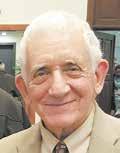
Dear Family and Friends, I have lived in Israel for almost a half a
I came here with my wife and raised my children here. My children and grandchildren have served in the army, Tzahal, and contributed greatly to civil society. But I could never have imagined that the leadership of this country would betray my love and trust.
ONLY A FEW DAYS AGO THEY DID SO.
Last week, the Knesset Legislative Committee voted that there will not be an investigation of the Oct. 7 war by a state commission as prescribed by the laws of Israel. Thus, we the citizens of Israel will never know, nor will the world, who made the mistakes which caused the war. Let all those who were killed
rise up and cry – “My country has betrayed me. I gave my most precious possession, my life. Why?”
Since this just occurred, I doubt whether the demonstrations have even been organized. Certainly, I cried many times in the last two years as I am sure you did. Now, what do I do -sign a petition - I cannot march, I cannot stand in the rain which will soon fall.
Please call your Federation if you feel this is an important event and ask, when the information reaches themwill they encourage community members to bombard the office of the Israel ambassador to USA, the honorable Yehiel Leiter, born in Scranton Penn., whose son was killed in this war, fighting against Hamas.
To me, much more important is to send letters to Prime Minister Benjamin Netanyahu indicating you have children of friends who were killed, even more heartrending, family members in Israel who were killed.
By Israeli law, the Supreme Court of Israel is mandated to appoint a retired Supreme Court Justice to head the commis-



sion as well as appointing the members. Golda Meir, of blessed memory, faced a commission after the Yom Kippur War. She wanted the world to know what her actual role in that war was. Does not seem that is the case now because the Government believes the Supreme Court is totally political and totally a fake.


Just wanted to share this information. The living hostages have returned. Hamas has found, said with tongue in cheek, some of the bodies - hopefully they can find all 28.
Shabbat Shalom. ì
Rabbi David Geffen is a resident of Jerusalem.


Rabbi David Geffen
Jerusalem resident Rabbi David Geffen questions why the Knesset Legislative Committee voted that there will not be an investigation of the Oct. 7 war by a state commission.
A Vine, a Fig Tree, and a Soccer Jersey

My collection of soccer jerseys is stuffed into a bedroom drawer and hanging in a closet.
There are national team shirts from the United States, England, France, Mexico, Spain, Belarus, Turkey, Greece, Jordan, Iraq, Thailand — and Israel.
Since Oct. 7, 2023, I have wondered how people would react if I wore the Israel shirt at the grocery, a local restaurant, or one of Atlanta’s neighborhood festivals.
In and of itself, a soccer jersey is not a statement of political opinion. Wearing an Israel jersey is not an expression of support for Israel’s government or its handling of the war in Gaza.
But in today’s highly charged atmosphere, anything labeled “Israel” may trigger a reaction.
This thought experiment came to mind as I reviewed a Washington Post poll of 815 Jewish American adults, in which 42 percent said they avoid wearing, carrying, or displaying items that might identify them as being Jewish.
Asked to assess their safety in the United States, 18 percent reported feeling very safe and 51 percent somewhat safe, while 26 percent reported feeling not too safe
and six percent not at all safe.
The respondents self-identified as being Jewish by religion or, if not by religion, then by ethnicity, culture, or family background, and were either raised Jewish or have a Jewish parent. The survey, conducted Sept. 2-9 by Social Science Research Solutions, came with a margin of sampling error of plus or minus 4.7 percentage points.
Combined with the surveys by the American Jewish Committee for the previous three years, the trend line for avoiding Jewish-identifying items is rising — 23 percent in 2022, 26 percent in 2023, 40 percent in 2024, and now 42 percent.
The sharp increase last year followed the Hamasled terror attacks in which some 1,200 men, women, and children were murdered and 251 kidnapped. Israel launched a punishing military campaign against Hamas, with a Palestinian death toll now estimated in the tens of thousands and much of the Gaza Strip reduced to rubble.
The language and signs at anti-war protests in this country often have veered from condemnation of Israel into anti-Jewish sentiment. Jewish individuals have suffered verbal abuse and physical assault, synagogues have been vandalized, and mob protests have disrupted operations at businesses and educational institutions.
Some Jewish Americans take care, particularly when traveling abroad, not to call attention to their religious identity, by wearing a ball cap over a kippah, for example. Conversely, others have responded by openly,
Beyond Your Expectations...
combining technology and artistry to create exceptional dentistry.

and perhaps defiantly, exhibiting items that might identify them as being Jewish.
The Washington Post poll reminded me of a January 2020 community rally in Sandy Springs, following violent, in some cases fatal, attacks against Jews in New York and New Jersey.
Rabbi Yossi New told a packed Byers Theatre at City Springs: “I am a Chasidic Jew. I look like many of the victims in Brooklyn and New Jersey. I know I’m stating the obvious, but it’s not how Jewish you look that causes antisemitism. The way one looks is merely the canary in the coal mine,” New said.
Mind you, I’m talking about a soccer jersey, not a star of David or Chai pendant, a kippah, or tzitzit
The Post reported that women (51 percent) were more likely than men (36 percent) to have avoided displays that might identify them as Jewish.
By age, 53 percent of Jewish adults under 35 years old said that they avoided such displays, compared with 45 percent ages 35 to 49, 40 percent ages 50 to 64, and 34 percent of those age 65 and older. The higher percentage among those under age 35 may reflect a response to antiIsrael fervor in their age cohort, people with whom they work, socialize, and interact.
My observation is that many Jewish Americans want to steer clear of even conversation about Israel, Zionism, and the war in Gaza, fearing that it will lead to confrontation.





George Washington, in his August 1790 letter to the Hebrew Congregation of Newport, R.I., wrote: “May the Children of the Stock of Abraham, who dwell in this land, continue to merit and enjoy the good will of the other Inhabitants; while every one shall sit in safety under his own vine and fig tree, and there shall be none to make him afraid.”
The Washington Post poll suggests that maybe onethird of the Jewish community feels that rather than good will, they are experiencing hostility stemming from their religious identification.
Washington drew the “vine and fig tree” phrase from the Book of Micah (4:4) in the Hebrew Bible. Let me suggest that, 235 years later, sitting under that vine and fig tree could be interpreted as being able to safely wear, carry, or display items that could identify someone as being Jewish.
That might include an Israeli national team soccer jersey.
For now, my thought experiment remains just that, a thought. And my Israel shirt remains in a drawer. ì
Dave Schechter
From Where I Sit
Dr. David Mastro
Dave has an Israeli soccer jersey hanging in his closet and wonders how people would react if he wore it at the grocery, a local restaurant, or one of Atlanta's neighborhood festivals.
Cheers to 100 Years
In recognition of the Atlanta Jewish Times celebrating its 100th year from its first edition in 1925, the AJT will re-publish articles from the Southern Israelite from editions dating as far back as 1929, the earliest edition available through the Digital Library of Georgia. All of the Southern Israelite editions, from 1929-1986, can be viewed at gahistoricnewspapers.galileo.usg.edu/lccn/sn78003973/
Please enjoy this retrospective of Jewish journalism in Atlanta and across Georgia, and thank you for supporting the Atlanta Jewish Times for the last 100 years.

These Couples Don’t Make Mountains Out of Matzo Balls
By Marcia Caller Jaffe
A Harvard study of 724 long-married couples showed that it wasn’t love, sex, nor children that kept them together. It was the ability to tolerate the same annoying things in each other repeatedly vs. the divorced group who tried to fix the other.
These nine Atlanta Jewish Times’ long-married couples (averaging 60 years) also learned not to suppress, but to release, choosing peace over being right. Herein our couples revealed some of their long-married secrets. Lyons Heyman joked that he made all the big decisions “like global warming and the national interest rates while letting Gail make “little” decisions like where to live and how to raise the children. Sheila Wilensky made sure her matzo balls were “floaters not sinkers” to please Larry (it took four tries to read the directions right on the Manischewitz box. Leo Benator (who passed just weeks before this article published) when first meeting Louise, grabbed her hips and called them “buttresses.” Jerry Cooper advises to never teach your wife tennis while playing tennis.
“A good marriage is like a game of chess – the husband may be the king, but the queen has all the moves” speaks to complexity and compromise. See how these nine colorful couples strove to be and stay on the same team.
Susie and Don Sommers
55 years
Wed: June 14, 1970, at Beth Israel Synagogue, Schenectady, N.Y.
How you met:
Don: At the Temple Chanukah dance. She was my girlfriend at my bar mitzvah.
Susie: Someone brought mistletoe to the dance, and Don danced with me and kissed me under the mistletoe. I was stunned!
Initial Attraction:
Don: I thought she was beautiful.
Susie: I saw Don dancing with all the other girls at the Temple dance, and he was a terrific dancer. I wanted to meet him.
Secret to a happy marriage:
Don: A continued supply of homemade matzah ball soup.
Susie: Go with the flow and take turns doing the dirty jobs. For example: Tell the kids we had to cancel vacation, pick up mother-in-law at the doctor’s, clean up after the dog. And always love the one you’re with!

Susan and Fred Feinberg 57 years
Wed: Aug. 18, 1968, at Baron Hirsh Synagogue, Memphis, Tenn.
How you met:
Susan: Sam Mislow introduced us. Fred walked over to my apartment at the Bordeau Apartments on Buford Highway from his apartment down the street on a rainy night because his car was stolen the night before. He asked me to drive him home; and I didn’t believe him, so he walked back to his apartment in the rain.
Initial attraction:
Fred: Susan volunteered to type my graduate school assignments; and her outgoing personality.
Susan: I was in the process of moving into another apartment and Fred volunteered to move all of my shoe boxes!
Secret to a happy marriage:
Fred: Giving space to your partner to do things they enjoy.
Susan: Finding something you enjoy together and for us it has been raising our children, enjoy our grandchildren, and traveling together.

Maxine and Ron Rosen
62 years
Wed: June 2, 1963, Pittsburgh, Penn.
How you met:
Ron: Maxine was a social worker assigned to a pediatric patient. I was a senior med student assigned to same patient. Maxine could not talk to the attending doctor or resident.
Maxine: True, but the only one I could talk to was Ron. We have been talking ever since.
Initial attraction:
Ron: Maxine had great legs.
Maxine: I actually preferred Ron’s roommate, but he was tenacious.
Secret to a happy marriage:
Ron: Staying by her side when her mother was dying.
Maxine: Mutual respect, trust, learning to listen and being there at the hard times. I was a marital therapist and frequently advised these same “secrets.”

Leo z"l and Louise Benator
69 years
Wed: Sept. 2, 1956, at B’nai Zion Congregation, Chattanooga, Tenn.
How you met:
Louise: Blind date. Leo initially backed out, but then the “replacement” had a death in the family, so Leo ended up coming after all. Chaperoning a BBYO dance, I had my back to the door, I felt these hands on my hips and a wisecracking voice said, “In the Navy, we call these Buttresses,” and I decided I don’t need this garbage, and without looking I decided I would never date him.
Leo: Blind date -- I didn’t want to go because I was dating someone in Atlanta. But when the other guy backed out, I decided I would.
Initial attraction:
Leo: During the evening, I felt like we had so much in common, and she was a very nice person. After the date, on the way back to Atlanta, I told my friend that’s the girl I am going to marry.
Louise: His intelligence and sense of humor.
Secret to a happy marriage:
Louise: Settling your arguments early, before you go to bed.
Leo: Saying yes!

ATLANTA THEN & NOW
Barbara Cristal and Robert Krasnoff
70 years
Wed: June 29, 1955, at the Progressive Club
How you met:
Robert: We met at a pledge party at AEPi at Georgia Tech. We “met-greeted” and went in opposite directions. Several months later, I asked her to the yearly IFC weekend gala.
Barbara: I had a date (he asked me three days prior- a big “no-no” in the 1950s). He was not to be denied, as he later crashed an after-function breakfast at my home. He outlasted my date and stayed ‘til 2 a.m. That was the spark that lit the flame. Physical attraction was very strong, but we also had similar tastes in music and humor.
Secret to a happy marriage:
Barbara: Don›' sweat the small stuff, which allows love and respect to grow.
Bob: There’s no issue worth an argument. Dislike confrontation -- especially with someone I love.
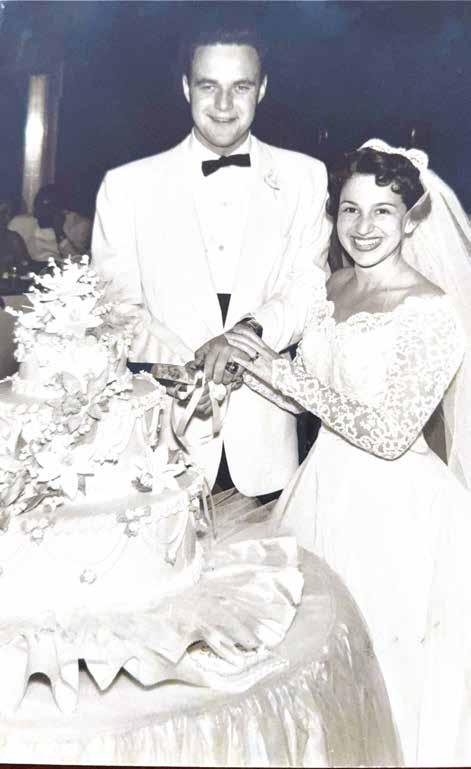
Jean and Jerry Cooper
66 years
Wed: Dec. 29, 1958, at Kingston Country Club, Kingston, N.C.
How you met:
Jerry: Jean moved to Atlanta to work at Rich’s. Jerry is an architect. His salary was $70 a week. College friend Sidell and Ted Frankel (AZA friend) set us up on a blind date. Meanwhile, their baby was sick, so we doubled with Barbara and Elliott Levitas.
Initial attraction:
Jean: Jerry was fun and smart and seemed impressive to me.
Jerry: Jean brought me into a world of sunshine. I fell for her at the beginning on the date.
Secret to a happy marriage:
Jerry: Never try to teach your wife how to play tennis while playing tennis. Overall, it takes a lot of determination, hard work, and overlooking the warts, we all have them.
Jean: Our children and grandchildren bring us joy. Jerry designed our home 60 years ago that we love today more than when it was initially built. It’s our haven of warmth and security that we created together; and we are so lucky to have each other.

Gail Goldstein and Lyons Joel Heyman, Jr.
51 years
Wed: June 30, 1974, at Ahavath Achim Synagogue
How you met:
Lyons: I had a car as a freshman at UGA and was picking up Gail’s sorority sisters for dinner. Gail jumped in the front seat next to me -- couldn’t catch my breath.
Gail: First day, winter quarter at UGA at a TEP and DPhiE dinner.
Initial attraction?
Lyons: She was very friendly and confident. And she didn’t mind that I was a Jewish “Jr.” from a small Georgia city, Rome. She was a “big city girl” and that was sexy.
Gail: I thought he was cute and nice and kind.
Secret to a happy marriage:
Lyons: I make all the big decisions like national interest rates, détente, global warning, etc. Gail makes all the little decisions like where we are going to live, how to raise the kids, where we go on vacation, household budget, etc.
Gail: Patience, understanding and acceptance.

Michael and Gail Habif
49 years
Wed: Aug. 15, 1976, at the Doral Hotel, Miami Beach, Fla.
How you met and the initial attraction:
Michael: August 1972 at a ZBT party during our freshman year at Tulane. I saw Gail from across the room talking with Paul Rubin of blessed memory. I was smitten with her beauty and personality from the moment he introduced us. We were friends until I asked Gail to go on a date which was Homecoming, Nov. 4. We were inseparable during the next four years of college.
Gail: In his dorm room while visiting his roommate, Paul. After being best friends for two months, I fell madly in love with him, his smile, gentleness, and compassion.
Secret to a happy marriage:
Michael: We’ve never had to work at it. We were meant to be together.
Gail: Marry someone who loves you with every fiber of their being … the same as you love them.


The Fountain of YOU
ATLANTA THEN & NOW
Sheila and Larry Wilensky
63 years
Wed: July 15, 1962, at Temple of Israel, Wilmington, N.C.
How you met:
Larry: We met at Sheila’s college roommate’s wedding, as she was marrying Larry’s fraternity brother; and both of us were in the wedding.
Initial attraction:
Larry: Sheila’s beautiful red hair.
Sheila: Larry had a fabulous smile and did anything he could to please me.
Secret to a happy marriage:
Sheila: We were ALWAYS each of our children’s best friends. It made for an amazing life!
Every track of land Larry looked at that looked ripe for development, he would call “a beautiful girl.” That began almost the month after we married, and we are still looking
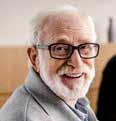


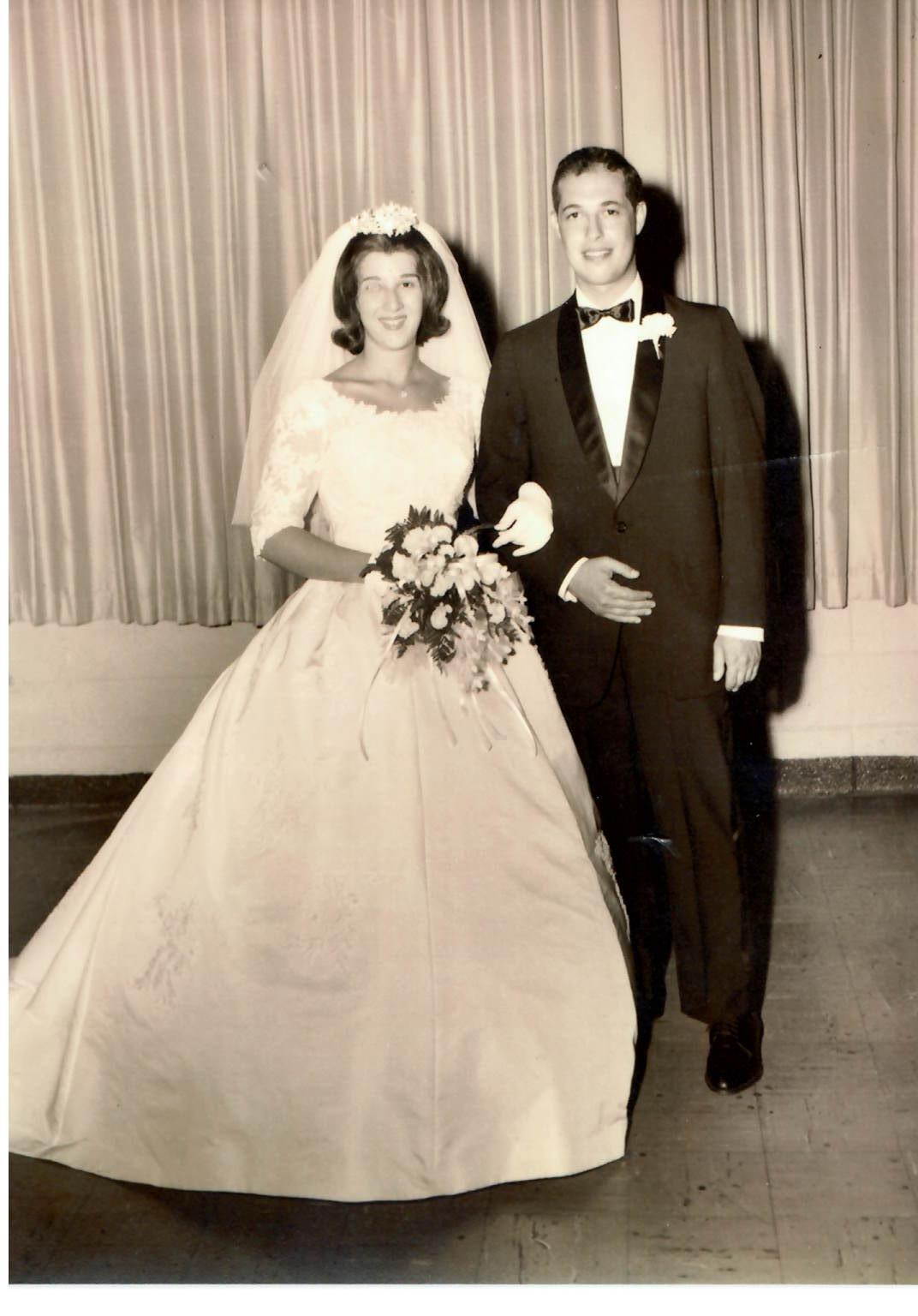



The Evolution of Toco Hills
By Chana Shapiro
In 1962, when Rabbi Emanuel Feldman presciently made the bold decision to move Congregation Beth Jacob to Lavista Road in Toco Hills (the synagogue was founded in 1943 and had held services in a couple of previous Atlanta locations), the irony of its new location must have been obvious. Surrounding homes in Toco Hills were on streets named Christmas, Merry, Bramble, Pinetree, and Holly — streets today that are home to Jews of every ilk, mostly Orthodox families.
Today, 53 years later, there are 10 synagogues in the Toco Hills area, and the latest two — Chabad of Toco Hills and Netzach Yisrael — moved from their original Toco quarters into new buildings on Lavista Road this year in time for Rosh Hashanah.
The synagogues underscore the diversity of the Toco Hills Jewish residents, most of whom live within walking distance of their houses of worship. The shuls are all in walking distance of
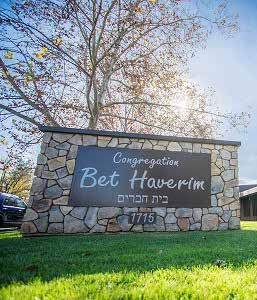

and support two or more synagogues. In this mixture of Jewish cultures, one finds four Orthodox (Chabad, The New Toco Shul, Beth Jacob, and Beth Jacob North), two Modern Orthodox (Ohr Hatorah and Shaarei Shamayim), one Reconstructionist (Bet Haverim), two Sephardic (Netzach Yisrael and Ner Hamizrah), and one Kol-

Indulge In A Home That



borhood any Shabbat morning to meet the hundreds of worshippers on their way to services.
Toco Hills has kosher restaurants, take-out places, and groceries. The Kosher Gourmet, which moved to Toco Hills from Virginia Highland in 1983, and The Spicy Peach, which opened in 2013, both provide kosher groceries, gifts, specialties, and fresh and frozen take-out foods. Kroger and Publix offer countless kosher options. The Toco Grill on Lavista Road opened in 2004 with a Middle Eastern vibe, and Chai Peking, in the Toco Hills Kroger, prepares kosher Chinese food. Restaurant Formaggio Mio on Briarcliff Road was founded in 2018, and Sababa’s Burgers, in the Toco Hills Shopping Center, opened in 2024.
To ensure that facilities maintain high kosher standards, the Atlanta Kashrut Commission (AKC) was established in 1979. Its director, Rabbi Reuven Stein, manages a staff of mashkichim, who, in addition to supervising venues throughout Atlanta, regularly supervise all of the Toco Hills food-service places. The AKC answers questions about all areas of kashrut, as well. Its offices are located on the Beth Jacob campus.
Parents, eager for their children to receive a Jewish education, once had limited choices: The Hebrew Academy elementary school, Yeshiva High School (at the old community center on Peachtree Road), or out-of-town schools (Memphis’ yeshiva was a popular choice for Orthodox Atlanta families). Today, there are three accredited Atlanta Jewish schools in the Toco Hills area. Elementary Torah Day School moved from its first rented quarters on Montreal Road to a large, new building on Lavista Road in 2003. Temima High School for Girls, founded in 1985, moved from trailers on the Torah
Day School campus into its own building on Lavista in 2015, and nearby boys’ Yeshiva Ohr Yisroel welcomed its first class in 2002. Additionally, the Beth Jacob preschool is now four times larger than in the 1960s.
In 1987, Beth Jacob Rabbi Ilan Feldman arranged for a Kollel (traditionally, a men’s advanced Jewish studies consortium) to come to Atlanta, with the specific purpose of outreach. The initial group of three Atlanta Scholars Kollel rabbis (ASK) has grown to 21 Kollel families. Atlanta’s ASK was the first outreach Kollel in the United States, with the goal of spreading Jewish learning beyond its own scholarly studies into greater Jewish Atlanta. ASK has its own building on Lavista Road, where it holds services, runs classes, and maintains a large beit medrash (study hall) for individuals and learning partners.
Unique Jewish community events characterize the Toco Hills neighborhood, most remarkably the annual Purim Parade which proceeds down Lavista Road on the Sunday preceding Purim, with floats, music, performers, and costumed marchers. Its first year was 1992. In 2017, members of the Toco Hills community worked together in Beth Jacob’s Heritage Hall where they were officially recognized by the Guiness Book of World Records for creating the world’s largest Israeli flag made out of cookies. The event raised $10,000 which was distributed among several Israeli nonprofits.
Following Hurricane Irma in 2017, Beth Jacob mobilized the Toco Hills synagogues to coordinate logistics to provide shelter, meals, and support to hundreds of displaced Floridian families, a powerful multi-shul, multi-week effort. Visitors stayed in neighborhood homes and met for meals in Beth Jacob’s Heritage Hall.
Congregation Bet Haverim is a Reconstructionist synagogue in Toco Hills.
Congregation Beth Jacob moved to Toco Hills in 1962.



In 1992, as the Jewish community grew, an eruv was constructed. (An eruv allows observant Jews to carry items on Shabbat within its boundaries). The eruv is inspected before Shabbat every week, and it is maintained through donations from Toco residents and a team of volunteers.
The first Toco Hills mikvah was built as part of Beth Jacob. Today, the freestanding Florence and Seymour Gerson Community Mikveh, completed in the late 1990s, is a modern building on Lavista Road. An outdoor kelim mikveh, in which certain types of kitchenware may be koshered, was built in 2006 by Sep-
hardic shul Ner Hamizrach on Lavista Road. The synagogue also constructed a community geneza, which is a repository for books and documents that may not be destroyed because they contain G-d’s name. Periodically, the geneza contents are buried. The geneza and kitchenware mikvah, both available to anyone in Atlanta, are maintained through voluntary donations.
It’s impossible to express the growth and character of the Toco Hills Jewish community without noting its many gamachs, which began to take root in the late 1990s. Gamachs are free-loan entities, with each gamach containing spe-
cific useful items to be borrowed, then returned for reuse — Jewish recycling. Today, there are more than two dozen gamachs in Toco Hills, located in designated spaces in private homes. Examples are medical equipment like wheelchairs and walkers, Purim costumes, tools, baby items, and folding tables and chairs. There is also a high-quality clothing gemach, with a dressing room and mirrors.
Changes are often challenging. Old timers from Toco Hills remember when there was one synagogue, no supermarkets well-stocked with kosher items, and few Shabbat-observant families. There
were no continuous sidewalks or crosswalks on Lavista Road between Briarcliff at one end and North Druid Hills on the other, and no traffic signals. A free-standing mikvah, gamach, or a geneza were only aspirations.
Today, Toco Hills newcomers find vibrant synagogues, excellent Jewish schools, adult education classes on all levels, numerous kosher food options, a modern mikvah, and an eruv. This developed community, however, is relatively new in breadth and depth. It has evolved gradually over the last 50 to 60 years, most substantially in the last 25 years, as needs and opportunities arose. ì

Congregation Shaarei Shamayim is one of two Modern Orthodox synagogues in Toco Hills.
Kosher Gourmet is just one of many kosher options in the neighborhood. The Spicy Peach in Toco Hills offers kosher delicacies and more.
The Jewish Businessmen Who Twice Saved The Fox
By Bob Bahr
The Fox Theatre, which stands today as a heady reminder of the glamorous role that these old movie palaces once occupied in American life, was originally conceived a hundred years ago as a lavish new headquarters for the Masonic members of Atlanta’s Yaarab Shriners.
But as plans progressed, so did the cost of construction and before they finally broke ground in 1928, the Shriners were forced to taken on one of Hollywood’s most important Jewish movie moguls as a full partner.
William Fox, who was born Wilhelm Fried Fuchs in Hungary, was building a national chain of lavish theaters for his Fox Film Corporation when he added the new Atlanta theater to his portfolio.
With his investment, the Shriners were able to have a building for their offices and a pair of ornate ballrooms for their meetings and Fox had a theater right out of the “Arabian Nights.” It had seats for more than 4,600 ticket buyers who could sit in their lavishly upholstered seats and imagine they were about to watch a motion picture in an exotic desert encampment surrounded by crenellated balconies and ornamented balustrades.
Overhead, the make-believe sky twinkled with pinpoints of light and clouds moved with the passing of time. It was almost too good to last, and from the start it almost didn’t. By the time it opened on Christmas Day in 1929, the stock market had crashed two months before.
Despite the financial setback, the opening day crowd stretched around the block on Ponce de Leon and Peachtree Streets. They showed “Steamboat Willie,” Walt Disney’s recent animated cartoon that introduced a new character, Mickey Mouse, in synchronized sound and Fox’s “Salute” starring George O’Brien and Helen Chandler. On stage was a musical revue entitled “Beach Nights” and rising from the orchestra pit on a 16-foot hydraulic lift was the Mighty Moller organ played by Iris Wilkins.
But it didn’t take long for all of this lovely dream-like setting to face challenges brought on by the Great Depression. In 1932, The Fox was repossessed and the building which had been built only a few years before for $3 million was auctioned on the Fulton County Courthouse steps for $75,000.
The Fox, which had been saved by one visionary Jewish businessman in


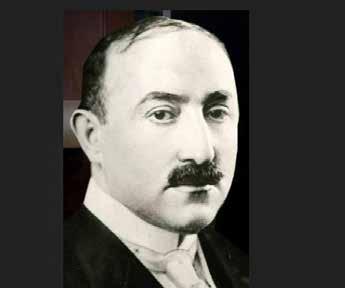
the 1920s, would have to wait more than 40 years for another Jewish visionary to save it again.
In 1974, after years of declining audiences who either were moving far away to the suburbs or were staying home to watch television, the old, once magical Fox was headed toward the wrecking ball.
The Bell South Company, a telecommunications giant, was planning a new corporate headquarters for the site. The demolition permit had just been issued when a determined group of civic-minded citizens decided that The Fox was well worth saving.
Georgia’s state government had done an economic study that The Fox had a future if it was run by a nonprofit organization. The new group, called Atlanta Landmarks, needed to quickly come up with the $1.8 million to buy the building.
It was slow going until what was described as an anonymous donor stepped in to promise that they would donate $400,000 if the new nonprofit could raise the rest. The effort succeeded and the group began a lengthy program to restore the old theater into its former glory.
It was only well after the campaign that Atlanta found out that the anonymous donor was Ben Massell, Jr., who ran the very successful real estate company that had been started by his father, a Lithuanian immigrant. The elder Massell had become one of Atlanta’s largest real estate investors and was an early developer of the neighborhoods north of Ponce de Leon Avenue.
His son was a supporter of the arts and became a leading benefactor of the High Museum of Art after his father died in 1962. He also was a prominent member of the Anti-Defamation League and
served as chair of its Society of Fellows and on the local board and in the Southern region.
After The Fox was purchased, Massell, Jr., became an active member of the theater’s restoration committee. He was a cousin of Sam Massell, who served as Atlanta’s first and only Jewish mayor between 1970 and 1974. A bronze memorial plaque was placed in the theater as a tribute to his timely generosity.
Today, 50 years after Ben Massell, Jr, helped save The Fox, the theatre is thriving. Last year, it hosted more than 200 performances attended by over 600,000 visitors who spent more than $50 million on tickets.
This month, The Fox was selected as Theater of The Year by the International Entertainment Buyers Association, one of the nation’s most important live entertainment organizations. ì
William Fox was an early movie mogul who bought into The Fox Theatre project during a crucial time in construction planning.
The Fox Theatre seats more than 4,600 in make believe splendor.
Ben Massell was an Atlanta businessman and civic leader whose contribution helped save The Fox in 1975.
Atlanta JCC Continues to Grow & Expand Its Reach
By Robert Garber
With construction from the Marcus Jewish Community Center of Atlanta’s (MJCCA) 2023 capital campaign coming to an end, the center is now a far cry from the farmland it was a century ago, when the organization that would become the Atlanta JCC was housed in a space far too small for it on Capitol Avenue, near where Turner Field would later stand.
The Jewish Educational Alliance (JEA), formed in 1909 by a merger between the recently formed Young Men’s Hebrew Association and the Free Kindergarten Association, would continue at this location until 1946, when it officially changed its name to the Atlanta JCC, in anticipation of a new building they began fundraising – which itself was not completed until 1956.
The new location on Peachtree Street had only just been completed when real estate mogul Max Kuniansky, then president of the JCC, began looking for an area in the rural farmland of Dunwoody where Jewish kids would have space to play outside the city during the summer heat. To help finance the endeavor, he recruited his friend, Erwin Zaban, and the land was purchased in 1961.
The 1960s were an enormous decade for the JCC. In addition to the purchase of the land that would soon become known as Zaban Park, and the founding of Camp AJECOMCE, the day camp located on the property (now known as Camp IsadoreAlterman), the JCC also purchased and developed land near Cleveland, Ga. – which was dedicated as Camp Barney Medintz in 1963. So many events and developments were occurring at this time that it necessitated a weekly, full-page section of this very paper (then the Southern Israelite), titled simply “AJCC NEWS,” to cover it all.
In 1979, the JCC broke ground on a building at Zaban Park. At the ceremony, according to a 2013 AJT article, Zaban was handed a comical award, a rooster in a cage, while everyone else received alarm clocks. Zaban was apparently known for calling very early morning meetings.
The center held the first Atlanta JCC Book Festival in 1992. A very different affair than this year’s book festival, it featured just two authors and was catered only with volunteer-baked cookies.
In 1995, two long-time JCC volunteers, Lisa and Ron Brill, donated $1 million to the JCC’s endowment fund – then the largest endowment gift in the organization’s history. Lisa Brill also became



Investments in the 2023 capital campaign have made new renovations, like the refurbished Halpern Plaza, possible.
JCC president that year, and closed the Peachtree Street location, formally moving the center to Zaban Park.
It was in 2000, however, after donations from Bernie Marcus and Arthur Blank allowed for significant renovations of the building and grounds, that the Marcus Jewish Community Center of Atlanta found its home in the newly renamed Zaban-Blank building. Crowning
this achievement, the JCC Maccabi games were hosted at the MJCCA the next year.
A decade later, in 2010, one of the most iconic and spiritual elements of the campus, the Abe Besser Holocaust Memorial – named after the survivor who made the monument possible – was added, and its ner tamid was lit.
Since then, the MJCCA has continued to grow, undergoing several renovations
and hosting many events – including another JCC Maccabi games in 2019. As construction funded by the 2023 capital campaign nears completion, reshaping the MJCCA once again, the investments made as recently as this year and as long ago as the 1950s continue to bear fruit for the local Jewish community.
Who knows what we will be remembering in another hundred years? ì
Arthur Blank, Bernie Marcus, and Erwin Zaban, among others, cut the opening ribbon for the newly refurbished and renamed Zaban-Blank building in 2000.
The MJCCA expanded its aquatic facility in 2023.
ATLANTA THEN & NOW
Friedman’s Shoes Stands the Test of Time
By Marcia Caller Jaffe
From 1929, a mere 96 years and growing, hails the story of a well-marketed Jewish retailer, Friedman’s Shoes, that spans generations. Phil Friedman started it, Bruce Teilhaber ran (and still runs) with the ball along with four sons still dressing some of the most illustrious athletes, men with large feet, and snazzy dressers.
Randy, the oldest, is the buyer, Lane runs the sales floor, Dean steers the Ladies division; and Brett, the youngest, captains the E-commerce -- Friedman’s Shoes on the Internet (LargeFeet.com --one of the first shoe businesses on the web in 1995).
In terms of maintaining success, Randy stated, “It’s mostly about our great customer service and niche in selling sizes seven to 22 but specializing in sizes 14 to 22.”
Looking back, Bruce developed a relationship with Churnin’s Shoes in Chicago. Within three years, Friedman’s became one of the only non-Florsheim shoe stores in the U.S. selling Florsheim Factory Blems (which Friedman shoemakers on site would repair and have ready to re-sell). Bruce started making larger sizes (14 and 15) in Italy as they were the only factories that would let him invest in the larger size lasts and could actually do the production.
Randy continues, “Once word got around, sports stars as well as the ‘who’s who,’ came here.”
A sports marketing genius, Bruce engaged Georgia Tech players, then word of mouth took over. He said, “Many athletes and performers (including The Rolling Stones) have come through the store. It has been a huge benefit being downtown with the major league teams close by as well as entertainment venues.”
Then came baseball stars, from Pete Rose to Henry Aaron (Dusty Baker remains friends with Bruce), as well as the NHL. NBA stars are in the Friedman’s “sweet spot,” not just the ones with large feet -- from Spud Webb (size seven) to Shaquille O’Neal (size 22). Shoes are made from soft butter leather to exotics like alligator, ostrich, lizard, snake and fish skin. They can price below retail because they put the Italian factory names in the shoes instead of brands like Prada and Gucci. The price point is less as there are no royalties. Friedman's also carries brands like Mezlan, Cole Haan, Marco Di Milano, and Calzoleria Toscana.
Ladies also get a “foot hold.” Dean has sold to many WNBA players and a
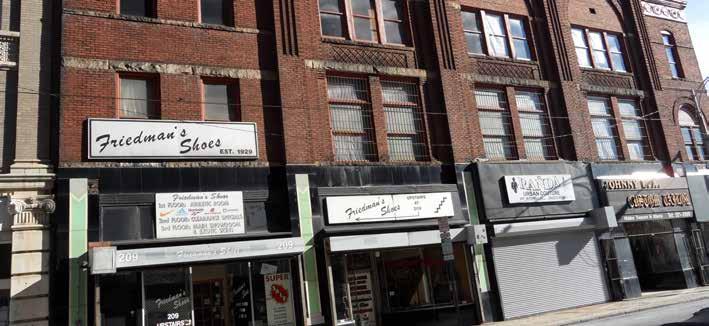

plethora of athletes’ mothers and wives. Shaq’s mom, Lucille, is one of Friedman’s best customers.
Brett is known for his vision to engage the web as he helped Zappo’s start their website which sold to Amazon for a cool billion. They have maintained a software database since 1992, where Lane sends photos of new shoes and styles via text to his faithful client list. They have an online catalog touting customers from Los Angeles to New York. Friedman’s is also known for their accommodating staff -- mostly family and others
who have been employed for more than 25 years. Service to them means “not being a clerk - offering suggestions about fit and fashion.”
Randy concluded, “Getting to work with my family for my entire life as well as being able to provide for my family, has meant more than words can say … our legacy is about honesty and good retailing. Not too many small independent stores have been lucky enough to be known throughout the world for the place to visit when in Atlanta to buy shoes.”
Bruce is 87 years old and drives himself to work. His hobbies are sports and “watching anything that is round.” He said, “The next generation will hopefully take it to the 100-year anniversary; and G-d willing one of the grandkids will step up and carry the torch.”
Friedman’s is located at 209 Mitchell St. Within the next year, they will move closer to the State Capitol. Security has improved with the South Downtown Group cameras and robotic dogs touring the area, along with the Atlanta Police Department’s influence on the street. ì
Friedman’s Shoes will soon move a few blocks away, close to the State Capitol building.
Brett Teilhaber, Walt “Clyde” Frazier, Bruce Teilhaber, and Earvin “Magic” Johnson
Riot Darkened Atlanta’s Reputation for Racial Peace
By Bob Bahr
Since the Civil Rights era of the 1950s and 1960s, Atlanta has courted economic progress and racial fairness with the now familiar slogan of “A City Too Busy to Hate.” But a in the early years of the 20th century, hate was not far from many of those who had been attracted to the opportunities that life in what was called “The Gate City” offered.
As many local historians have pointed out, racial differences were exploited by the intense rivalry that had developed by the four newspapers that were read in the white community. Lurid stories about Black men attacking white women were frequent. This seething undercurrent came to a head on Saturday, Sept. 22, 1906.
As recounted by the Atlanta History Center, thousands of angry whites massed at the intersection of Pryor and Decatur streets in downtown Atlanta. Despite an attempt by Atlanta Mayor James Woodward to calm the crowd, the mob attacked hundreds of Black residents and vandalized Black-owned businesses in the downtown area.
By Monday, Sept. 24, the central business district was under martial law. At least 25 Black Atlantans were murdered and hundreds more were injured as Black businesses and homes were burned or destroyed. Black residents were, in some cases, hung from lampposts and others shot or stabbed to death.
The racial violence in Atlanta was widely noted in the press. In Paris, Le Petit Journal featured a drawing of a rampaging mob attacking numerous Blacks. The international press reports that quickly appeared were not unlike those that appeared after a similar massacre that had occurred in 1903 in the Jewish community of Kishinev in Russia. Photographs taken in Eastern Europe of recently murdered Jews wrapped in white cotton shrouds appeared in major newspapers.
Although the mob violence left a dark shadow across Atlanta history, over the years it was largely forgotten, It was not until 2006 on the 100th anniversary of the rampage that there was a public ceremony here commemorating the attacks.
Now the National Center for Civil and Human Rights has unveiled a largescale mural of the 1906 attacks. It covers one side of a building housing a neighborhood organization on McDonough Boulevard in the Atlanta community of Brownsville, south of downtown.
The area had played an important

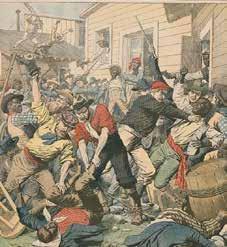

role in the riot and over the years has remained an important part of Atlanta’s history. The artist, Fabian Williams, took more than 14 months to create the final work, maneuvering through 19 versions of the mural until he was satisfied with the results.
In imagery reminiscent of the French newspaper drawing, the mural shows an angry white mob attacking Black citizens reconstructing a home. Although guns played an important role in the historical event, Williams was asked not to include the weapons in his final version.
The National Center has also developed an immersive mobile app, “1906,” that uses augmented reality to bring the history of the massacre to life. Included in the work are eyewitness and newspaper accounts of the event.
In the aftermath of the event well over a century ago, the civic community
took steps to ease Black and white relations. A committee was formed with the participation of Dr. David Marks, rabbi of The Temple in Atlanta, to take steps to ensure that what had happened on the streets of the city over those several days would not reoccur.
One of the most sensational of the city’s newspapers, the Atlanta Evening News, was forced to close. Dialogue between leaders of each racial community was stepped up. The riot was one of the reasons the National Association for the Advancement of Colored People was formed in 1909.
But tension persisted because many of the conditions that had led to the riot remained. Blacks remained an underclass, seen with suspicion and disdain by their white neighbors, tensions continued to run high as Atlanta transitioned from a largely agricultural economy to an industrial one. Sensational journal-
ism continued to play on people’s emotions.
As Atlanta’s rapidly growing Jewish community prospered and grew, so did the resentment and antisemitism that bubbled up from time to time.
It could be argued, as some historians have, that the 1906 race riot can be linked to the trial and conviction of Leo Frank seven years later. It also was influenced by sensational newspaper accounts that played up the sexual overtones in the murder of 13-year-old Mary Phagan.
Just as how the race riot had led to the violent death and even lynching of Black men, so Leo Frank who was convicted of Phagan’s murder was taken from his prison cell by a vengeful white mob. He, too, was finally hung from a large tree in a publicly celebrated crime in 1915 that had repercussions for decades. ì
Reports of the 1906 Atlanta massacre were read in Paris, where one newspaper, Le Petit Journal, ran this cover drawing.
Artist Fabian Williams works on his large-scale mural of the 1906 race riot that was recently completed in south Atlanta.
Martial law, backed up by the state militia, finally ended the riot.
EDUCATION
AJA Students Build Edible Sukkot Davis Academy’s Season of Rejoicing



Atlanta Jewish Academy students celebrated Sukkot with creativity and joy — building edible sukkot and enjoying fun games in the sukkah! Hands-on





learning and festive spirit come together at AJA.
Compiled by AJT Staff

We Buy & Sell


Parkaire Landing Shopping Center 4880 Lower Roswell Road, Suite 175, Marietta, GA 30068
www.adamarkjewelers.com | 770-565-6558 Monday-Friday- 10am – 6pm | Saturday- 10am – 4pm

Sukkot was a time of joy, connection, and reflection at The Davis Academy as students from Mechina through eighth grade celebrated this special holiday together. On both campuses, students helped decorate two beautiful sukkot inspired by the tzedek (righteousness and social action) themes woven into their grade-level curriculum. These themes — ranging from caring for the Earth and animals in the early grades to embracing diversity and pursuing justice for marginalized populations in the upper grades — came to life through art, writing, and hands-on projects. The sukkot became vibrant expressions of student learning and Jewish values, filled with color, creativity, and meaning.
Throughout the week, classes gath-
Eighth-graders Izzy Flome, Hannah Dresdner, Avi
, and B
Davis are decorate the
ered in the sukkah to learn, share meals, and reflect beneath the leafy roof. Families were also invited to join a special session with Rabbi Micah Lapidus and the Davis Parenting Network marking two years since Oct. 7 — an opportunity to come together in solidarity, to listen and be heard, and to envision a path forward grounded in empathy, resilience, and shared responsibility.
As students and families alike spent time in the sukkah, they were reminded of what truly matters: the simple blessings of family, health, and shelter. Rooted in tradition yet filled with youthful spirit, Sukkot at The Davis Academy was indeed z’man simchateinu — the season of our rejoicing.
Compiled by AJT Staff
Gates
ryn
sukkah.
An AJA student displays his edible sukkah.
AJA students enjoyed constructing edible sukkot for the holiday.
Atlanta Jewish Academy students build edible sukkot.
First-grade student Jake Brekke is shaking the lulav with his classmates.
Fifth-grader Layla Lincoln and classmates in Hebrew class are pictured under the sukkah.
Eighth-grader Max Mendes decorates the Sukkah at the middle school campus.
A Joyful Celebration of Community & Tradition Torah Day School Celebrates Sukkot

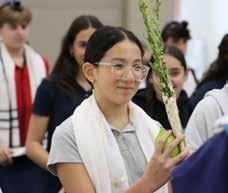



The Epstein School was filled with the joy of Sukkot as students, faculty, and staff embraced the beauty and meaning of this special holiday and its significance. Integrating leadership and teamwork, the eighth-grade students constructed one of the two campus sukkot for the elementary and middle school students to enjoy. This special space becomes a hub for tefillah, shared lunches, and joyful gatherings throughout the week.
Adding to the joy this year, the Epstein Early Childhood Program (ECP) welcomed a new sukkah designed espe-
cially for the school’s youngest learners. The ECP students loved having lunch and snacks inside their sukkah, experiencing the holiday, its traditions, and its mitzvot.
Sukkot at Epstein is truly more than a celebration — it is a living expression of Jewish values, gathering as a kehillah (community), and gratitude. Throughout the week of Sukkot, students fulfill the mitzvah of shaking the lulav and etrog, they create meaningful memories together and connect with the history and meaning of the holiday.
Compiled by AJT Staff


When it comes to the Jewish holidays, experiential hands-on learning takes precedence at Torah Day School of Atlanta. TDSA built excitement for the holiday of Sukkot in a number of fun ways.
In STEAM class, Mrs. Pelishev presented the students with a simple challenge: How long can you make a paper chain using just one sheet of paper? Working in teams the students experimented with different width strips, different numbers of strips and different sized loops. In their last class before Sukkot break, the students measured their
paper chains to see whose was the longest.
The second graders constructed their own etrog (citron) boxes. Guided by Rabbi Avi Rubin, the students used a drill press, sanders, and screw drivers (with proper safety gear) to build their boxes from scratch. It’s always a great experience for the students to see a woodworking project come together. The students were proud of their handiwork, which they decorated after proudly useing during Sukkot.
Compiled by AJT Staff
In STEAM class, Torah Day School students crafted paper chains to celebrate Sukkot.
The second graders at TDSA constructed etrog boxes with the guidance of Rabbi Avi Rubin
Eighth-grade students at The Epstein School construct a sukkah on campus.
Seventh-grader Maya Chun shakes the lulav and etrog.
Epstein Early Childhood students enjoy lunch in the sukkah.
Grant Levison helps put together the sukkah structure.
Marley Rattray assists with construction of the sukkah.

Students Enjoy Sukkot at The Weber School EDUCATION
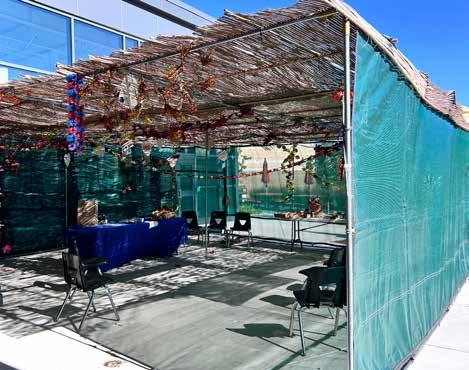




Weber’s sukkah was artfully decorated.
Under the guidance of Rabbi Adam Mayer, dean of tenth-grade students and Mashpia Ruchani (spiritual and religious counselor), Weber students and faculty transformed the school sukkah into a joyful and welcoming space. Colorful paper garlands with students’ handwritten Rosh Hashanah prayers for a sweet New Year joined autumnal and symbolic decorations, draping the sukkah with their personal hopes and blessings.
Throughout the holiday, students gathered in the sukkah to shake the arba minim (lulav, etrog, hadas, and aravah), to learn, reflect, and share meals together. Students and faculty loved having classes in the sukkah, learning and connecting with each other — and a bit of sunshine — in a joyful outdoor setting.
To add some unique flavors (literally) to this year’s festivities, students enjoyed a special Sukkot lunch featuring a beloved Lower East Side classic: Green’s Chocolate Babka. Straight from Brooklyn, this world-class pastry offered a sweet and nostalgic taste of Jewish culinary tradition.
The celebration culminated with Shemini Atzeret and Simchat Torah, as students and faculty filled the Eitan Force Athletic Complex with music and dancing. This year, the joy carried a deeper resonance as the community celebrated the release of 20 hostages from Hamas captivity, taken exactly two years earlier on this same holiday.
Compiled by AJT Staff
Students at The Weber School constructed this sukkah for the holiday.
Weber students shake the lulav and etrog.
Chaya Mushka Chabad Academy Receives Accreditation
By Sasha Heller
Chaya Mushka Chabad Academy (CMCA) recently announced that the school has earned accreditation from the Southern Association of Independent Schools (SAIS).
To receive accreditation, CMCA had to meet SAIS’s esteemed standards of educational quality, conduct a rigorous self-study, and perform a comprehensive evaluation by education professionals.
“This achievement means so much to our entire school community,” CMCA Executive Director Rabbi Isser New said. “SAIS accreditation recognizes not just the strength of our academic program, but the culture of collaboration, care, and growth that defines our school. It’s a celebration of everyone’s effort, our faculty, students, parents, and supporters and a reminder that we’re all working together to create the best possible experience for our students.”
Becoming a SAIS-accredited school places CMCA among a respected international network of independent schools recognized for their excellence in educa-



tion and continuous improvement, according to a news release.
“It is a true mark of distinction, one that speaks to the strength of our community and the quality of learning that we provide,” Rabbi New said.
School officials also announced that CMCA will become a full partner school with the Jewish Federation of Greater Atlanta.
“This partnership will deepen our connection to the broader Jewish community and open up new opportunities
for collaboration, growth, and shared purpose,” said Rabbi New.
Rabbi New explained that partnering with Federation means the school will be able to collaborate effectively with other schools and the community at-large and avails CMCA to the resources provided by Federation to core partner schools.
“We are so proud of how far CMCA has come and even more excited for what’s ahead,” said Rabbi New. “Together, we will continue to build on this foundation of excellence, ensuring that CMCA
BEN FRANKLIN ACADEMY
remains a place where our students learn, grow, and thrive in accordance with our shared values and mission.”
Founded in 2009 with its first-grade class, CMCA has grown each year and features a student-to-teacher ratio of six to one. CMCA welcomes families from all denominations, not just Chabad. Students hail from more than 20 zip codes, including Sandy Springs, Alpharetta, Toco Hills, Intown, Dunwoody, Marietta, Kennesaw, and Decatur. Transportation and carpool options are available. ì


CMCA was founded in 2009 with its first-grade class.
Chaya Mushka Chabad Academy students are pictured reading and enjoying some snacks.
Chaya Mushka Chabad Academy recently earned accreditation from the Southern Association of Independent Schools.
Atlanta Jewish Day Schools Utilizing New Tech
By Robert Garber
At a time when many public schools are struggling to manage the relationship between students and technology, many Jewish private schools are moving cautiously yet confidently towards advancing them in an accessible manner.
“Each grade focuses on the same weekly computer science concept, but instruction is differentiated to meet the developmental needs of each student,” writes Stacy Brown, director of innovation and professional learning at Davis Academy, in an article in Davis’ The Journey magazine describing their yearlong computer science and engineering course. “This ensures that students develop a strong foundation in computational thinking and design-build skills that they can apply to real-world problems."
The class integrates learning about algorithms as early as kindergarten through to having them code their own games using Javascript or Python in the fifth grade.
“Upper elementary students engage in discussions about the subjective biases embedded in AI, using Code.org’s AI programs to demonstrate how human biases influence machine outputs,” writes Brown. “For example, when prompting AI to associate the word ‘delicious’ with a fish, students see how AI reflects the biases of its creators. Students deepen their understanding of both the capabilities and limitations of AI, leading to new insights and discoveries.”
Integrating both the use of and education about generative AI into the curriculum is a significant point of interest at other schools as well.
“We started with the goal of AI competency and literacy over AI usage,” says Elizabeth Behar Powell, a social studies teacher at The Weber School who is also the school’s educational technology specialist. “The idea is we want to support kids in understanding how to use AI as a tool, as opposed to using AI to replace their own work.”
Powell, who has held this position at Weber for three years, and an additional two years at her previous school, notes that she really started seeing generative AI like ChatGPT becoming a presence in education in the spring of 2022.
“Internet research has always been a component of our classes. AI has pushed us to make it a more deliberate integration.”
And Jewish schools have certainly been doing so.
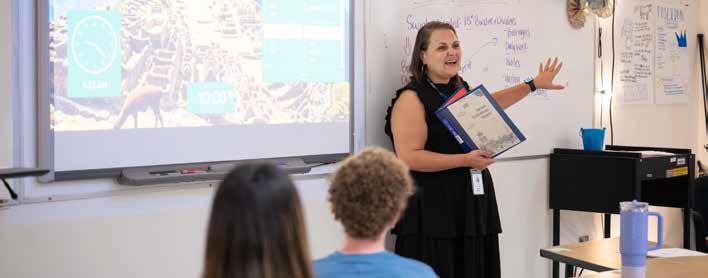
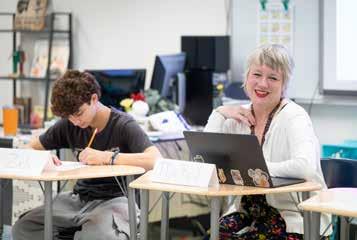

A recent project undertaken by middle schoolers at Atlanta Jewish Academy examined whether AI could analyze and teach Gemara, comparing the results of different models. They came to a series of conclusions – some noting the models’ inconsistencies, others noting the importance of the user’s knowledge base on fact-checking results, still others noting the range and level of details across models. Meanwhile, AJA high schoolers interviewed AI models “channeling” figures from the Jewish enlightenment and critically analyzed their conversations with them.
“The biggest hurdle with AI is the changing landscape of it. It is changing, and improving, and there are issues with it that are coming almost hourly at this point,” said Powell, commenting on AI’s use in research and the classroom setting. “I’ve told our teachers – history teachers, anyone teaching research had to adapt when Wikipedia became a thing. Math teachers had to adapt when
Mathlab and those types of applications became a thing. So, this is just another level of teachers learning how to adapt and help our students in the best ways possible.”
As for whether it makes sense to limit students’ access to technology, Powell notes that, while Weber is not a cell phone ban school, they do ask students to turn in their phones at the beginning of each block.
“They have been doing that for years, [ever] since I’ve been here,” said Powell. She notes it gives them a sense of autonomy, but also acknowledges the benefits of shared technology, such as a shared notes document for all the students in a class.
Meanwhile, AJA is moving towards increasing cell phone restrictions, asking parents to refrain from giving their kids smartphones until eighth grade. For higher grades, they are still trying to keep students involved in the conversation and have implemented a multi-student
committee interface with them on the subject.
“There has been talk in AJA about how the administrators and teachers are becoming more stringent,” read an article written by Leora Sokol for AJA’s student-run magazine, Palette, “but the phone committee acts as a way to prove to the students that the administrators are listening to advice.”
Across the board, it seems equipping students with the skills to navigate changing technology, and putting them at the forefront, isn’t just a helpful educational strategy, but an absolutely necessary one.
“I’ve been teaching – this is my 13th or 14th year teaching – and I tell my kids the first school where I taught, we did not have wi-fi,” said Powell. “So, adapting with the changing world, with accessibility to technology, that’s something that they will have to do at a much more rapid, much faster rate than you and I had to do.” ì
Students at Atlanta Jewish Academy give a detailed presentation.
Weber School teacher Sheri Bouhi gives a presentation for a social studies class. The question of using AI in research has become a topic of conversation in such classes.
Weber School teacher Vanessa Reid sits next to student Zach Brown during an English class. Teachers have encouraged using tools for correcting written work over generating it.
Celebrating 55 Years of Joyful Learning
Building independence in every child through supportive relationships, joyful learning, and meaningful work in a Montessori environment. Join us as we celebrate our 55th year in education, a brand new lower school building, and the launch of the first authentic Montessori high school in the southeast!
Open House: Saturday, January 24th 2026
Now enrolling ages 18 months old to 9th grade for the 2026-2027 school year. 2998 Lavista Road, Decatur GA 30033 • 404-321-9304 • www.arbormontessori.org
Arbor Montessori School admits, embraces, and does not discriminate against people from all diverse backgrounds and groups including, but not limited to, differences in cultures, race, ethnicity, gender identity, sexual identity, socioeconomic status, religion, abilities, neurodiversity, and family structure to all the rights, privileges, programs, and activities of the school. It does not discriminate in the administration of its educational policies, admissions policies, scholarship and loan programs, and athletic and other school-administered programs.

ARTS & CULTURE
Elvis’ Jewish Guru was a Hollywood Hairdresser
By Bob Bahr
Elvis Presley’s life, who had rocketed to fame after he cut his first recordings in Memphis in 1954, would be irreparably changed by a chance meeting a decade later.
On Thursday, April 30, 1965, he was in Hollywood and needed a haircut. He had an assistant needed Larry Geller, a 24-year-old hairdresser who had developed a following of famous names, working for several years in Jay Sebring’s famous salon. Their fateful meeting and its impact on the King of Rock’n’roll take up a full chapter in Peter Guralnick’s recent book, “The Colonel and The King.”
That April afternoon, almost 60 years ago, Geller drove to Presley’s home on Perugia Way in the Bel-Air section of Los Angeles where he spent a pleasant and largely routine 45 minutes washing and cutting the star’s hair. But he was taken aback by a question, suddenly posed.
“Larry, let me ask you something, I mean, you’re a great hair stylist and all,” Elvis said, “but what are you really all about? What are you really into?”


The answer Geller gave Presley that day transformed the relationship the two men had, and helped make Geller, who had been born into an Orthodox Jewish family, one of the star’s closest confidants.
“My main interest, which is really the most important part of my life, is my search






for truth, for G-d, and for a greater understanding of myself.”
That answer touched off a three-hour conversation that began with the books on religion and the spiritual life that Geller had grown up with. He touched on the ideas inherent in the study of Kabbalah, the medieval Jewish mystical practice that was enjoying a resurgence of interest in the 1960.
Kabbalah’s emphasis on the Ein Sof, G-d’s infinite presence, and the psychological structure of the sefirot that are present in each individual soul was finding new adherents in Jews and Gentiles, alike. The turn from the materialism inherent in everyday life in America had brought about a new interest in spirituality and the journey of the soul through life.
The decade-long climb that Elvis had experienced since his days as a young truck driver who dreamed one day of becoming a star had happened all too quickly and had left Presley bewildered and searching for answers that fame had not provided.
“Why me, Larry?” Geller quotes him as saying in their first meeting. “Why was I picked out of all the millions of people to be Elvis Presley?”
Geller was about to leave when Presley paused for a moment then asked him to quit his job with Sebring and work for him.
“Larry, I sure don’t believe in coincidences. You came here for a reason more than just doing my hair. Just meet me at Paramount Studios tomorrow morning at eight o’clock. And Larry … don’t forget, you gotta bring me a few of those books you’ve been talking about.”
For the next three years, Geller and Elvis were inseparable. He gradually put together a library of hundreds of books with a heavy emphasis on Eastern and Western spirituality. He also introduced Presley to
the leader of the Self Realization Fellowship, which had been founded by an Indian mystic, Parmahansa Yogananda, that was headquartered in Los Angeles.
But he also provided many the classics of American spiritualism that flowered in late 19th century America and continued to be a major force in American life for the next hundred years.
Presley eventually began wearing a pendant around his neck with the Hebrew letters chet and yud, spelling out chai, the word for “life.” It was in part a tribute to the Jewish hairdresser, who in a few short years had become a kind of spiritual guru who traveled everywhere with the singer and the two trunks that contained part of the library of well-worn books Elvis read regularly. It also may have been an acknowledgment that his great-great-grandmother was Jewish.
Guralnick is generally recognized as the leading authority on the singer’s life. He believes that the deep relationship Presley formed with Geller helped fill a deep emotional need that formed after the sudden death of the performer’s mother in 1958.
In the mid-1960s, according to Guralnick, the relationship eventually began to drive a wedge between himself and every one else, except Geller. For them, Geller became as Guralnick quotes his wife, Priscilla, “a total threat to us all.”
Eventually, the Colonel would engineer a break between the two, but not before one final Presley masterpiece. In late May of 1966, he recorded the tracks that became his album “How Great Thou Art.”
Although it is strongly rooted in his religious faith, it can also be seen as a tribute to his Jewish spiritual guide, Larry Geller. It sold three million copies and won Presley the first of three Grammy Awards. ì
Larry Geller (right) and Colonel Tom Parker (left) eventually clashed over Geller’s influence on Elvis Presley who stands between them.
The latest book by Elvis biographer, Peter Guralnick is, “The Colonel and The King.”
Klibanoff Digs Up Another Season of ‘Buried Truths’
By Bob Bahr
Hank Klibanoff, the Pulitzer Prizewinning author and journalist, has returned with another series of “Buried Truths” podcasts for WABE. It’s been more than two years since Klibanoff was last heard on the local National Public Radio affiliate, but his latest series has lost none of its punch. It’s a fascinating look back in history that uncovers how justice was sometimes meted out in the racially troubled American South during the 1940s and 1950s.
In his latest series, he recounts the story of Clarence Pickett, a one-time wellknown preacher whose mental health in middle age was deteriorating. Four days before Christmas in 1957, he set off to pick up his paycheck at The Columbus World, a Black-owned newspaper where he worked selling advertising. He never made it.
Before that December day was over, he would be arrested for causing a public disturbance, jailed in Columbus, Ga., and then, when he continued to be a noisy and disruptive prisoner, he was beaten by a white police officer so badly, he needed medical attention.
Despite a cursory medical exam a day later, he was dead. For Klibanoff. Clarence Pickett’s sudden death 68 years ago and the way the case was handled then offered yet another quest to search for buried truth.
“These podcasts have all been about racially motivated killings or killings by white people who were racially conditioned,” Klibanoff says. “But this goes one step further and discusses medical neglect and the medical racism that ensued after the victim was beaten up.”
The young doctor who saw Pickett at the Columbus Medical Center had only recently completed his medical training at Tulane Medical School. After a cursory exam that didn’t include any of the tests that physicians would have been routinely ordered on a patient who had just been beaten senseless, he wasn’t admitted to the hospital or provided emergency treatment.
The physician concluded, instead, that he thought the patient was “putting on,” perhaps faking his condition. Klibanoff says that the way poor Blacks were often treated by white doctors in areas of the Deep South were not much different than what Clarence Pickett experienced.
“There was a disparity in the way Black patients are treated by white doctors, historically, back in those days,”
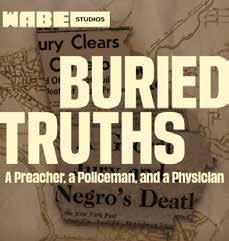


Klibanoff points out, “and it’s now been well established. And in this podcast, we go into the many mythologies that white doctors had about Black people and their health. This doctor had an opportunity to save and extend the life of Clarence Pickett, and he didn’t do it.”
If that was all you could expect for many white doctors at the time, Klibanoff points out, then you could expect far less from the police. In Columbus, the police headquarters was in a building they shared with the offices of the Ku Klux Klan. State laws in Georgia protected police officers from prosecution and even in the rare case like this one where an officer was prosecuted, they were quickly exonerated by a sympathetic jury. Justice, as “Buried Truths” has concluded in its five seasons of podcasts, has often been blind.
“There will never be justice in the criminal justice system for any of these people, but there is a judgment of history,” Klibanoff concludes. “And I believe very firmly that the last word on many of these cases is that if you examine them now, which we do, they will show that justice was not served. Justice was perverted back in those years.”
The podcasts that Klibanoff has produced over the years are the result of a unique partnership that has been developed between WABE and Emory University, where Klibanoff guides students through the cases he’s selected. In each instance, he gives his students a quick historical overview of the case, outlines some important journalistic principles for them to observe, then lets them loose to develop a new perspective and new leads to solve the cold case.
In recent years, he has worked to involve the federal government in helping to make federal law enforcement re-
cords more available. He’s a presidential appointee to the Civil Rights Cold Case Records Review Board, which was established in 2019 by an Act of Congress. It recently made available nearly 6,000 pages on its website of new records collected after the sensational murder of Emmett Till in Mississippi in 1955.
For his work on “Buried Truths,”
Klibanoff and his former producer, David Barasoain, who now teaches at the University of Florida, were awarded some of broadcasting’s highest honors. They won a Peabody Award in 2018, a Robert F. Kennedy Award in 2019, an Edward R. Murrow Award in 2021, and an American Bar Association Silver Gavel Award in 2021. ì

The “Buried Truths” podcast developed out of a class taught by Hank Klibanoff at Emory University.
The fifth season of “Buried Truths” explores the death of 49-year-old Clarence Pickett in Columbus, Ga.
Hank Klibanoff has been presenting “Buried Truths” for WABE since 2018.
Torres Crafts Unique Judaic-Themed Art
By Marcia Caller Jaffe
Cuban native Alexi Torres uses oil, metal, fiber, and his own vivid imagination to create touching, wild, and wildly different Judaic-themed art from his West Side Studio near The Works on Chattahoochee Avenue, where his wife, Julie, also an artist, shares the 6,500-squarefoot studio.
To connect the dots, Torres explains, “I have many collectors, some from Israel and some from here. I feel a relation from my homeland and Israel -- both are small countries trying to find freedom, having their people all around the world for different reasons. I think there is not a lot of Judaic art out there; and I have tried to create some which have done very well for me. Many Jewish people seem to have a great appreciation for art, supporting art and artists and building great collections.”
The late Bernie Marcus’ collection in Boca Raton, Fla., is an example. Torres is best known for oils that are painted to appear as if knitted or woven. Often, he takes inspiration from everyday organic items like leaves, basket weavings, cloth or feathers, and more recently, the harsher stainless steel.
To get started in the Jewish milieu, Torres began with the Israeli flag. “Years ago, I began creating a series of flags, which I still make today. For each piece, I collect images of objects that represent the culture of the country of the flag. Using my basket weaving style, I then paint all those objects on top of the outline of the flag. A few years ago, I got a commission to paint a large flag of Israel and while creating that piece, I delved deeper in the culture, people, and traditions.”
In addition to Jewish-themed art, Torres’ work is in some very visible places. He created an 18-foot piece for an Atlanta collector for which he painted hundreds of objects and symbols that contributed to humanity’s evolution. He has paintings in airports throughout the country. One of his favorites is a 23-foot painting of the Wright Brothers at Delta Sky Club in Concourse B at Atlanta’s HartsfieldJackson airport. His exhibitions include Miami’s Contessa Gallery; UNIX Gallery, New York; Marietta Cobb Museum Of Art; DMoMA Lausanne, Switzerland, 2013; Hoover Library, Alabama; Rush Gallery, New York, 2012; Kai Lin Art, Atlanta, 2012; Scope Miami; and the collections of Will Smith, Los Angeles; Hoover Public Library, Hoover, Ala.; David Mills, San Francisco, Calif.; Lewis Brisbois Bisgaard
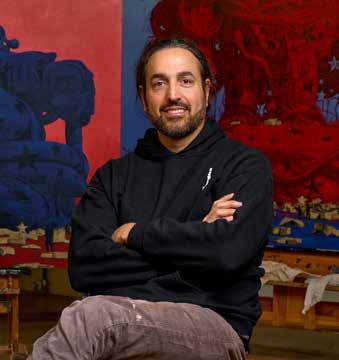


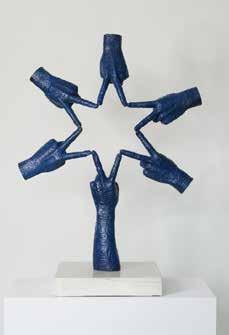

“Mind Control” is described as “out there.” This “Tree of Unity 1” starts with blue fingers and bronze. “My Night Lights IV” uses thread on black burlap done with 1,411,252 stitches.
& Smith, Atlanta; Ruth Beardsley, Australia; Laura Rathe, Houston; and Law & Moran, Atlanta.
He explained, “I follow ideas and execute them the most effective way possible. I am fascinated by how our mind works and how we make things happen with our thoughts and our focus.”
Each work usually takes a few months to complete. Torres follows a moon cycle like farmers in Cuba to plant and harvest the crops. He begins each painting on a waning moon and finishes
a few months later on another waning moon. He records the dates with his signature on the canvas. He created a series of embroideries that range from $2,000 to $6,500. The price for oil paintings and sculptures depends on size and complexity -- small paintings start at $10,000 with the price topping $100,000 for the larger works. He is working on six to 10 paintings concurrently.
Of Torres’ Judaica collection, Miami client Niki Lipkin said, “Our spectacular Torres piece casts a glow upon our wall,
warmly welcoming us into our home and reminding us of the strength of our people. The many hands holding candles, lighting the way as we move forward while simultaneously echoing the memories of those loved and lost. It is a cherished piece that Alexi masterfully created and we are proud to have in our home.” In Atlanta, Torres is represented by Carousel Fine Art Gallery Buckhead. He will meet private clients by appointment at the studio. For more information, please email contact@alexitorres.com. ì
Alexi Torres sees similarities in the cultures and countries of Cuba and Israel.
“The Land of Israel” was done in 2024.

Chai Style Home
Chef Brings in Light with Spiraling Modern Drama

Modeling the Guggenheim Museum where spacious rooms of soaked white curves and angles serve as a backdrop for edgy art, Chef Nadia Deljou feels “an elegant sense of comfort, togetherness, and warmth — where family and friends instantly feel at ease and connected” in her Sandy Springs home.
Crisp white and timeless ecru lends a certain stillness alongside unchartered Zen both indoors and out. To add to the layering, Nadia turned to her Persianborn parents, art maven Kamy and Roya Deljou, to make creative decisions. “Our lifestyle has always been about teamwork. Each of us brings our own talents and love into the equation, and together we make the best of what we can. We all share a creative side, though in different ways — some more visual, others more emotional, the rest more rooted in compassion and experience.”
Marcia: So, how was this a family
affair?
Nadia: When it came to design and finishes, we all pitched in. My dad was more focused on the actual execution of the vision, while my mom and I leaned into the selection process — furniture, finishes, colors, and the details that bring everything to life. In the end, it was a really enjoyable project that borrowed from all of our tastes and strengths. There’s a piece of everyone in this home and that feels really special.
Marcia: What did you like about the house to draw you away from the Beltline buzz vs. this suburban feel?
Nadia: The moment I walked in, I understood Kamy’s encouraging push to always seek bigger and better — the house felt like the perfect place for the next chapter of my life. I gravitated toward the open space, the natural light, the layout. The house is modern, like my childhood home, the house my parents still live in. It feels naturally artistic in architecture, something I’ve learned to value as the daughter of an artist.
Marcia: You have a full commercial kitchen downstairs and this kitchen on the main level. How does your culinary business fit in?
Nadia: I recently shifted the core of my business, focusing mostly on R&D at home, while all the cooking takes place at a commercial location, Bistro at River Ridge, or clients’ homes. This way, I can keep my business and living space separate, which gives me peace of mind. I cook at clients’ homes, providing either weekly meal prep, or curating multi-course dining experiences for their guests. We focus on Middle Eastern flavor profiles and emphasize vegetable-forward cooking. A popular feature is “Carrot 3 Ways,” with curry brown butter, chilies and herbs, or our steak with celeriac and black garlic puree, and sumac demi-glace. My personal kitchen upstairs on the main level is for personal cooking and family enjoyment.
Marcia: The bones of that kitchen?
Nadia: My sister, Tallia’s, in-law’s own a stone company, Luxor Tile and Stone. For the countertops, including the exquisite waterfall with the countertop and backsplash, we had them fabricate a gorgeous piece. The cabinets were already in such great shape that we didn’t want to replace them.
Dad knew an incredible cabinetry finisher, whom we hired to repaint the cabinets to give them a more modern
look, and my color vision turned out perfect! For the light fixture over the island, we had to rig a special device to position the centerpiece light properly, since it was slightly off-center. My dad is great with things that require a challenge and putting things together to create a full vision.
Marcia: In addition to natural lighting?
Nadia: In my opinion, the best lighting, aside from the kitchen countertop, is what we did in the powder room. By using an onyx stone and under-lighting the unit, it creates a soft, cozy, and even romantic atmosphere, especially against the dramatic black walls.
Marcia: And the art?
Nadia: We got to hand select a few art pieces from Deljou Art Group, most of them are figures, or faces of women — the main piece in the dining room is an abstract wide piece of women riding horses on resin. One of my favorites is the shadow box piece of a woman’s profile, the detail in her eyelashes is amazing.
Marcia: The furniture pulls it all
Marcia Caller Jaffe
Nadia relaxes with Shiloh on a chenille textured couch from Roche Bobois // All photos by Howard Mendel

Above: The dining room’s west wall is exposed to the outdoors via a balcony rich with greens from the garden. The hanging pendants are Japanese-style bird nest shaped lighting fixtures. The painting is a horizontal piece with a glossy finish resin, riding horses in the distance.
Right: Nadia calls the onyx vanity in the guest powder room “somewhat romantic” as its dramatic feel illuminates against the black walls of the space.
Below: Owner of Delle Dining, Nadia keeps her personal kitchen separate from her professional one. Quartz countertops are laced with gold. The lighting above took complicated engineering to install.

together.
Nadia: My color palette is neutral, whites, blush pinks, golds, soft taupe, browns. The floor is bleached pine which lifts the lighting and makes it feel cozy and bright. We curated a lot of the furniture from Roche Bobois and Cantoni, Arhaus for the dining room, Horizon Home and Direct Furniture for bedding.
Marcia: Describe the primary bedroom.
Nadia: We completely redid the vanities, mirrors, light fixtures, and other details. There was also a small window to the outside. My dad, our architect, Alex Munoz, and my cousin, Michael, with Emanuel Properties, came up with a plan to turn the window by the bed into a door! We then built a beautiful deck outside, complete with a spiral staircase under my cousin’s supervision that leads you right down into the backyard. Here we can sunbathe, grill, or read on the balcony.
Marcia: So, there are various outdoor venues off the different levels?
Nadia: We have multiple porches, the main one next to the kitchen has a raised bed garden where we planted fresh herbs and flowers, and a nice couch we use to enjoy the beautiful weather. The one off the master is used for access to the backyard, and the one off the main entrance of the house, I like to enjoy with guests when we host dinner parties for family and friends as it’s right next to the dining room.
Marcia: So, what’s next for you?
Nadia: Writing a cookbook and coming up with more recipes to highlight my unending love for carrots. ì




Top Left: One of the several Zen-filled gardens off the home’s plazas.
Top Right: The formal living room shows Nadia’s office on top right, the bar (center), and hallway leading to the casual family room laden with three vertical light fixtures reminiscent of vinyl records.
Below: Kamy created this Persian representation of the word “love” using layers of resin, diamond dust and a blow torch.
Left: The dramatic front foyer (left) has a checkered figurine piece, setting the tone with golds throughout the home. On the right is a hand-curated installation of delicate butterflies

CALENDAR

Daily
Chattahoochee Nature Center’s Naturally Artistic Interactive Exhibits – 10 a.m. to 5 p.m. Experience the beauty of art and nature intertwined at Naturally Artistic, a seasonal interactive exhibit at the Chattahoochee Nature Center. This year’s theme, Ecological Patchwork, explores how we are all interconnected through the natural world around us. As you journey through the grounds, you’ll be invited to reflect, journal, and engage in creative activities that inspire a deeper appreciation for nature and the ties that unite us all. Purchase tickets online at https://tinyurl. com/ye6bebdn.
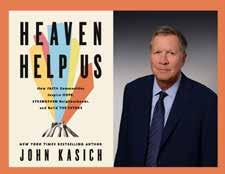
Saturday, November 1
MJCCA Book Fest: Governor John Kasich, Heaven Help Us – 8 to 10 p.m. Gov. John Kasich, “Heaven Help Us: How Faith Communities Inspire Hope, Strengthen Neighborhoods, and Build the Future.” From former governor and presidential candidate John Kasich comes the gripping stories of ordinary people doing extraordinary work through the support of faith communities. Discover the antidote to cynicism and despair in this dynamic, revelatory, hope-inducing exploration of the work and people who are transforming communities around the country -- motivated by faith. Join MJCCA and purchase tickets at https://tinyurl.com/33vubk9b.

Sunday, November 2
Play Tamid - 9:15 to 11 a.m. Play Tamid is led by Rabbi Jordan and is open to the public (members and non-members of Congregation Dor Tamid). Enjoy crafts, songs, fun activities, and more for children under 4 (parent/guardian must attend). RSVP at https://tinyurl.com/3farjzrc.

PJ Library Zoo & You: Noah’s Ark Celebration at Zoo Atlanta - 9:30 a.m. to 12:30 p.m. A morning of fun, animals & adventure at Zoo Atlanta — ticketed event. Join PJ Library for a wild morning of fun at the Atlanta Zoo as we celebrate the animals of Noah’s Ark — two by two! Bring your family and explore the wonders of the animal kingdom at a special subsidized rate. Stop by the PJ Library table at the zoo entrance to pick up your tickets and say hello. Then, head inside for a self-guided adventure through the zoo with your PJ friends. Let’s make memories, spot some animals, and celebrate the stories that bring us together! Register at https://tinyurl.com/24uvx9xm.

MJCCA Book Fest: Alexander Bruner & Christine Kuehn – 1 p.m. The 34th Edition of the Book Festival of the MJCCA presents Alexander Bruner (author Jozsef Debreczeni, Z”L), “Cold Crematorium: Reporting from the Land of Auschwitz”; Chrisine Kuehn, “Family of Spies: A World War II Story of Nazi Espionage, Betrayal, and the Secret History Behind Pearl Harbor.” Reserve your tickets at https://tinyurl. com/yvys2ma9.
The Nightingale of Iran: A Family’s Story – 2 p.m. Sisters Danielle Dardashti (Emmy Award-winning documentarian) and Galeet Dardashti (renowned musician and anthropologist of Middle Eastern Jewish culture) uncover the mystery of why their family left Iran, revealing painful secrets unspoken for generations. Join The Breman by registering at https://tinyurl. com/ky4b47hy.

Virtual Candle Lighting – 7 p.m. Join us for SOJOURN’s next virtual candle lighting! This year SOJOURN is finding new, accessible, and meaningful ways to connect. Please join us for our third event where we will reflect on the theme of Remembrance and Renewal, hear SOJOURN updates about LGBTQ+ justice, and together kindle light for hope, solidarity, and love that transcends barriers. Bring a candle and let’s light the way together! Register at https://tinyurl.com/36tbc2u9.
MJCCA Book Fest: Senator Chuck Schumer, Antisemitism in America – 7:30 p.m. In an urgent and personal new book, Senate Minority Leader Chuck Schumer sheds light on the Jewish American experience and sounds the alarm about the troubling resurgence of antisemitism. Get your tickets at https://tinyurl.com/yrj3hf2n.
Monday, November 3
MJCCA Book Fest: Tova Mirvis & Cynthia Weiner - 12 p.m. Join the MJCCA Book Festival and listen to Tova Mirvis, “We Would Never: A Novel,” and Cynthia Weiner, “A Gorgeous Excitement: A Novel.” Find tickets at https://tinyurl. com/4vda2nfs.
MJCCA Book Fest: Christine Brennan, On Her Game – 7:30 p.m. A news-making and electrifying portrait of sports phenomenon Caitlin Clark, whose dramatic ascendance in college basketball and now in the WNBA has captured the attention of media and fans unlike any other female team-sport athlete in history — by awardwinning USA TODAY columnist and television commentator Christine Brennan. Reserve your tickets at https://tinyurl. com/mr4d7t3t.

Tuesday, November 4
MJCCA Book Fest: L. Dickerman, C. Mathis, B. Schaefer - 12 p.m. A three-author debut fiction panel featuring: Laura Dickerman, Catherine Mathis, and Brian Schaefer. In conversation with Mara Davis, Atlanta media personality. Author talk, Q & A and book signing. Purchase tickets at https://tinyurl.com/yc5cjzzs.
Stories of Science, Hope & Resilience – 7 to 8:30 p.m. Join us for a compelling panel discussion moderated by Elana Frank, CEO and founder of the Jewish Fertility Foundation, featuring Dr. Matt Goldstein, physician-scientist, entrepreneur, and CEO of JScreen, who is advancing accessible, life-saving genetic testing inspired by his family’s personal journey with TaySachs disease. He’ll be joined by Karen Arnovitz Grinzaid, JScreen’s founding executive director and genetic counselor, and Dr. Rachel Shulman, a maternal-fetal medicine specialist with expertise in prenatal genetics and reproductive health. Together, they’ll share insights on the power of carrier screening, the intersection of science and personal experience, and how community awareness and compassion can help shape healthier futures. RSVP at https://tinyurl.com/2m764hyy.

MJCCA Book Fest: Daniel Kehlmann, The Director – 7:30 p.m. A visionary tale inspired by the life of film director G.W. Pabst, who fled to Hollywood to resist the Nazis only to be forced to return to his homeland and create propaganda films for the German Reich. An artist’s life, a pact with the devil, and the dangerous illusions of the silver screen. Find tickets at https:// tinyurl.com/2bek6239.
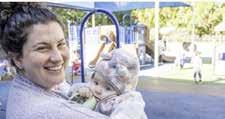
Wednesday, November 5
JBaby Dunwoody Neighborhood Small Group- 11:30 a.m. to 12:30 p.m. A five week small group series for local families to bond over music, education, support, and playtime. Designed for babies ages 0–12 months and their parent(s). In this warm, welcoming space, neighborhood families come together for playful learning and meaningful support. You’ll connect with other parents, learn from developmental experts, and share new experiences with your little one — building friendships and a deeper connection to your community along the way. Sign up at https://tinyurl. com/355wk9td.
CANDLE-LIGHTING TIMES
Torah Reading: Lech-Lecha
Friday, October 31 Light Shabbat Candles: 6:27 PM
Saturday, November 1 Shabbat Ends: 7:23 PM
Torah Reading: Vayeira
Friday, November 7 Light Shabbat Candles: 5:21 PM
Saturday, November 8 Shabbat Ends: 6:17 PM
Torah Reading: Chayei Sarah
Friday, November14 Light Shabbat Candles: 5:16 PM
Saturday, November15 Shabbat Ends: 6:13 PM
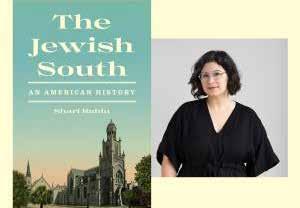
MJCCA Book Fest: The Jewish South – 12 p.m. Drawing on a wealth of original archival findings spanning three centuries, Shari Rabin sheds new light on the complicated decisions that Southern Jews made — as individuals, families, and communities — to fit into a society built on native land and enslaved labor and to maintain forms of Jewish difference, often through religious innovation and adaptation. She paints a richly textured and sometimes troubling portrait of the period, exploring how Southern Jews have been targets of antisemitism and violence but also complicit in racial injustice. Reserve your tickets at https://tinyurl.com/2serjykp.

The Big Kick: Atlanta’s Return to the World Stage and its Economic Legacy
– 5:30 to 7 p.m. The Jewish Commercial Real Estate Network (JCREN) unites Atlanta’s top real estate leaders to fuel the future of Jewish Atlanta. This exclusive gathering, one of only two each year, offers a rare opportunity to connect with peers, expand your network, and help shape a thriving Jewish community. As Atlanta prepares for a historic milestone, the 2026 FIFA World Cup, the city’s first sporting event of its scale since the 1996 Olympics, we’ll explore what this spotlight means for our economy, infrastructure, and hospitality sector, and how Jewish real estate leaders can drive impact at the center of it all. RSVP at https://tinyurl.com/yrj6ma4n.

MJCCA Book Fest: Sarah Hurwitz, As a Jew – 7:30 p.m. In “As a Jew,” Hurwitz documents her quest to take back her Jewish identity, how she stripped away the layers of antisemitic lies that made her recoil from her own birthright and unearthed the treasures of Jewish tradition. With antisemitism raging worldwide, Hurwitz’s defiant account of reclaiming the Jewish story and learning to live as a Jew, without apology, has never been timelier or more necessary. Purchase tickets at https://tinyurl.com/5wd88mvv.

JFF-NATIONAL Jewish Clergy Gathering on Infertility – 8 to 9:15 p.m. Infertility touches countless individuals and families in the Jewish community, often in silence. This national gathering of rabbis, cantors, educators, and Jewish communal leaders will provide a space for honest discourse, learning, and connection around one of the most pressing yet under-discussed issues in Jewish life. Clergy will explore the emotional, spiritual, and communal dimensions of infertility and identify ways in which our communities can become sources of strength, compassion, and inclusivity for all who struggle to build their families. Join JFF for a virtual Jewish clergy gathering on infertility by visiting https://tinyurl.com/32vykmh9.
Thursday, November 6
Chabad at The Dupree – 12 to 1 p.m. Join us for Chabad at The Dupree, a monthly lunch and learn series offering meaningful Torah study, good food, and community connection. Open to men and women, each session features a different Chabad rabbi from across Georgia, sharing Torah insights and inspiration. Classes are held at The Dupree, a beautiful and exciting new hub for Jewish life and activity. There is no cost to join Chabad at The Dupree. A delicious catered lunch will be served. Please RSVP in advance at https://tinyurl. com/3zjp7nrb to indicate your attendance.

Annual Rothschild Lecture to Feature Dr. Laura Arnold Leibman on “Rethinking Jews and Race: A Multiracial Jewish Family in Early America” - 7 p.m. The Tam Institute for Jewish Studies (TIJS) at Emory University will feature Prof. Laura Arnold Leibman of Princeton University as the speaker for this year’s Rabbi Jacob M. Memorial Rothschild Lecture. To secure a seat, advanced registration is requested at https://tinyurl.com/ m4kjkacz.
MJCCA Book Fest: Molly Jong-Fast, How to Lose Your Mother- 7:30 p.m. “How to Lose Your Mother” is a compulsively readable memoir about an intense mother–daughter relationship, a sometimes chaotic upbringing with a fame-hungry parent, and the upheavals that challenge our hard-won adulthood. A pitch-perfect balance of acceptance and rage, humor and heart, “How to Lose Your Mother” tells a universal story of loss alongside a singular story of a literary life. This is a memoir that will stand alongside the classics of the genre. Reserve your tickets at https:// tinyurl.com/888jb894.
Friday, November 7
Beyond the Headlines: Israel’s History, Society, and Politics – 8:30 to 9:45 a.m.
“Beyond the Headlines: Israel’s History, Society, and Politics” is a dynamic fourpart experience led by Dr. Eli Sperling, the Israeli Institute teaching fellow in the University of Georgia’s Department of International Affairs. Journey alongside fellow learners as you trace Israel’s transformative path from the dawn of modern Zionism through statehood and into the rich, layered realities of today. Join The Dupree by registering at https://tinyurl.com/yc4sb8sf.

Music and Play – 11 a.m. to 1 p.m. Let’s spark joy and curiosity through the magic of music and play! Jumpstart your morning with an upbeat, interactive music and movement class led by Here We Grow, where little ones can dance, wiggle, and sing their hearts out. Afterward, Nurture invites children into a world of themed sensory play and hands-on adventures — perfect for curious minds and messy fingers. Come ready to move, create, and make memories together! Learn more at https://tinyurl. com/2hjtnj9a.

JBaby Intown Neighborhood Small Group – 11:30 a.m. to 12:30 p.m. A five week small group series for local families to bond over music, education, support, and playtime. Designed for babies ages 0–12 months and their parent(s). In this warm, welcoming space, neighborhood families come together for playful learning and meaningful support. You’ll connect with other parents, learn from developmental experts, and share new experiences with your little one — building friendships and a deeper connection to your community along the way. Register at https://tinyurl. com/ydb388ta.
MJCCA Book Fest: Dorie Greenspan, Dorie’s Anytime Cakes - 12 p.m. From beloved James Beard Award–winning and New York Times bestselling author Dorie Greenspan — a vibrantly illustrated collection of recipes for simple yet mostmemorable cakes. Over the years, Dorie has created thousands of excellent recipes. And out of all of them, the ones she always comes back to are the simplest cakes. With evocative writing, expert advice, and gorgeous illustrations by Nancy Pappas, “Dorie’s Anytime Cakes” celebrates the simple — but still exciting and special — with more than 100 recipes for easy-to-make, easy-to-love cakes. Find tickets at https:// tinyurl.com/dvfrrhah.
Candler Concert Series: Cameron Carpenter, Organ – 8 to 10 p.m. Experience J.S. Bach’s Goldberg Variations and Mussorgsky’s “Pictures at an Exhibition” in ground-breaking arrangements by organist and composer Cameron Carpenter. Hailed as "extravagantly talented" by the New York Times, Carpenter is the first organist ever to be nominated for a Grammy Award for a solo album. Purchase tickets at https://tinyurl.com/39bv5sf7.

Saturday, November 8
MJCCA Book Fest: Debbie Gibson, Eternally Electric – 8 to 10 p.m. In her longawaited debut, Debbie Gibson reflects on the lessons she learned in her years as a young pop pioneer and on her hardearned journey to embrace her authentic self, allowing her to lead the healthy, engaged — and electric — life she does today. Purchase tickets at https://tinyurl. com/2zyz4vzw.
Sunday, November 9
Flags at Atlanta Cemeteries-Jewish War Veterans – 10 to 11:15 a.m. Our flag-placing mission for Veteran’s Day at Arlington Memorial Park and Crest Lawn Memorial Park will take place on Sunday, Nov. 9, starting at 10 am. Please join us so we can honor our departed heroes with American flags. As always, children, grandchildren, siblings, and other family members and friends are most welcome to join us. Sign up at https://tinyurl.com/m9s5ans.
CDT’s Fall Market – 11 a.m. to 3 p.m. Beat the holiday rush with Congregation Dor Tamid. There will be 20+ vendors, a bake sale, and lunch to purchase. The first 100 people in attendance will receive a swag bag. Visit https://tinyurl.com/35w37m9y for more information.








2025 Atlanta Kosher BBQ Festival -12 p.m. to 4 p.m. The Hebrew Order of David announces the return of the 2025 Atlanta Kosher BBQ Festival to Brook Run Park. Our festival is centered around a Kosher BBQ competition where approximately 25 teams compete in kosher brisket, beef ribs, chicken, and chili categories. We have a large Vendor Village, children’s activities, music, a silent auction, and of course BBQ. The Atlanta Kashruth Commission supervises the Atlanta Kosher BBQ Festival. Because we are fully compliant with their kosher food handling requirements, all spectrums of the Jewish community can participate, plus, because it is BBQ, the entire Atlanta community joins us as well. This ultimately makes us the most diversly attended food event in Georgia. Learn more at https://tinyurl.com/5h6s8k7n.

MJCCA Book Fest: Sophie Menin, A Year in the Vineyard – 1 p.m. With over 180 stunning photographs, “A Year in the Vineyard” offers an immersive experience of the adage “wine is made in the vineyard,” as it traces the yearlong cycle of the vine, from bud burst to harvest to vine leaves capturing the energy of the late autumn sun. The book also shows winegrowers as they work on the front line of the climate crisis, posing questions, and offering potential remedies in response to the earth’s changing ecology. Reserve tickets at https://tinyurl.com/mswmmwzz.
An Evening Honoring Sharon Rosenfeld – 6 to 8:30 p.m. Join Ramah Darom in honoring Sharon Rosenfeld and her extraordinary 26 years at Ramah Darom. As Sharon retires from her role as director of development & board relations, we celebrate her exceptional leadership, legacy, and impact on behalf of our community. RSVP at https://tinyurl.com/3tvjd9s9.
MJCCA Book Fest: Rabbi Angela Buchdahl, The Heart of a Stranger – 7:30 p.m. From the first Asian American to be ordained as a rabbi, a stirring account of one woman’s journey from feeling like an outsider to becoming one of the most admired religious leaders in the world. Today, Rabbi Buchdahl inspires Jews and non-Jews alike with her invigorating, joyful approach to worship and her belief in the power of faith, gratitude, and responsibility for one another, regardless of religion. Find tickets at https://tinyurl.com/ hu5rp4mj.

Monday, November 10
MJCCA Book Fest: Alton Brown, Food for Thought – 7:30 p.m. The acclaimed cookbook author, beloved culinary personality, and food science expert, is a must-read debut collection of food essays, cooking tips, kitchen stories, and behindthe-scenes insights, all infused with his signature wit and flair. From cameraman to chef, musician to food scientist, Alton Brown has had a diverse and remarkable career. Purchase tickets at https://tinyurl. com/4k9c4enc.
Tuesday, November 11
Jewish Professionals for Rainbow Youth Summit – 9:30 a.m. to 4 p.m. Join SOJOURN for the first ever Jewish Professionals for Rainbow Youth (JPRY) Summit! This summit is intended for professionals who work with youth in a Jewish setting. JPRY will highlight the ways that teachers and youth-facing staff can create supportive environments and respond to the needs of LGBTQ+ youth in their Jewish communities, with a focus on those working with trans and non-binary youth. Register at https://tinyurl.com/y4h7j5pm.
NCJW/ATL Mitzvah-in-Motion – 11 a.m. to 12 p.m. Join NCJW/ATL for our monthly mitzvah project! We will be assembling food boxes with New American Pathways to support refugee families. No registration necessary. Advocacy letter writing will immediately follow the mitzvah project. Get more information at https://tinyurl.com/ mm8dxvxa.
MJCCA Book Fest: Jen Glantz & Jean Meltzer – 12 p.m. The 34th Edition of the Book Festival of the MJCCA presents Jen Glantz & Jean Meltzer. Find tickets at https://tinyurl.com/2s48kuxw.

MJCCA Book Fest: Alyssa Gross, Play Mahjong – 7:30 p.m. “Play Mahjong!” is your comprehensive guide to the American version of the game, packed with interactive step-by-step instructions, helpful tips, tricks, and fun facts designed to enhance your playing experience. This entertaining and immersive look into mahjong also explores the rich history and cultural significance of the game and its ability to build a community among players. Reserve your tickets at https://tinyurl.com/bdeman8u.
Wednesday, November 12
Community of Giving – 8:30 a.m. You’re invited to a celebration of your impact! Join us Nov. 12 for Community of Giving and support our JF&CS Annual Campaign. The morning will feature inspiring personal stories from clients and remarks from our new CEO Jay Cranman. Support a path to dignity, purpose, and hope for those who need it most. Kosher breakfast served. Business casual attire. RSVP at https://tinyurl.com/c2bhc6zp.
JBaby Dunwoody Neighborhood Small Group- 11:30 a.m. to 12:30 p.m. A five week small group series for local families to bond over music, education, support, and playtime. Designed for babies ages 0–12 months and their parent(s). In this warm, welcoming space, neighborhood families come together for playful learning and meaningful support. You’ll connect with other parents, learn from developmental experts, and share new experiences with your little one — building friendships and a deeper connection to your community along the way. Sign up at https://tinyurl. com/355wk9td.

MJCCA Book Fest: Georgia Hunter & Mary Morris – 12 p.m. The 34th Edition of the Book Festival of the MJCCA presents Georgia Hunter & Mary Morris. Get your tickets at https://tinyurl. com/9th6jmwu.
MJCCA Book Fest: Jake Cohen, Dinner Party Animal – 7:30 p.m. From the New York Times bestselling author of “Jew-Ish” and “I Could Nosh,” and star of A&E’s “Jake Makes It Easy,” comes a fun, unfussy, and inventive collection of recipes to entertain with ease and enjoy any day of the week. Reserve tickets at https://tinyurl. com/3z4438bx.

Thursday, November 13
2025 National Human Relations Award Dinner – 6 to 9 p.m. AJC Atlanta proudly presents the 2025 National Human Relations Award to John M. Haupert, president & CEO, Grady Health System, in recognition of his visionary leadership and steadfast dedication to advancing equitable healthcare access and strengthening Atlanta’s communities. Register at https:// tinyurl.com/49n86f33.

MJCCA Book Fest: Elyce Arons, We Just Might Make It After All – 7:30 p.m. A moving portrait of friendship by Elyce Arons as she reflects on her long relationship with Kate Spade, whom she met in college and with whom she co-founded her namesake multi-billion-dollar fashion company, Kate Spade, as they came of age in 1990s New York. Purchase tickets at https://tinyurl.com/bdhan26r.
Friday, November 14
Music and Play – 11 a.m. to 1 p.m. Let’s spark joy and curiosity through the magic of music and play! Jumpstart your morning with an upbeat, interactive music and movement class led by Here We Grow, where little ones can dance, wiggle, and sing their hearts out. Afterward, Nurture invites children into a world of themed sensory play and hands-on adventures—perfect for curious minds and messy fingers. Come ready to move, create, and make memories together! Learn more at https://tinyurl. com/2hjtnj9a.

JBaby Intown Neighborhood Small Group – 11:30 a.m. to 12:30 p.m. A five week small group series for local families to bond over music, education, support, and playtime. Designed for babies ages 0–12 months and their parent(s). In this warm, welcoming space, neighborhood families come together for playful learning and meaningful support. You’ll connect with other parents, learn from developmental experts, and share new experiences with your little one—building friendships and a deeper connection to your community along the way. Register at https://tinyurl. com/ydb388ta.

MJCCA Book Fest: Russ & Daughters, 100 Years of Appetizing – 11:30 a.m.
From the legendary New York destination for Jewish appetizing comes a beautiful and inspiring cookbook that encompasses history, tradition, and absolutely delicious food. In 1907, a Jewish immigrant named Joel Russ landed in New York City, where he took a pushcart of herring and built a legacy that would pass down through fathers and daughters (and sons and husbands and wives) for more than a hundred years. Four generations later, the ancestral heart of Russ & Daughters continues to bustle on the Lower East Side, with three more locations throughout the city. Reserve tickets at https://tinyurl.com/b27tdtj7.

Shabbat, Me & Rabbi G @ The JCC – 5 to 5:30 p.m. Experience the joy of Shabbat with Rabbi G! This exciting celebration is fun for the whole family, featuring lively Shabbat songs, heartfelt blessings, and delicious challah and grape juice. This is the perfect way to close out the week in a fun and casual setting. Find out more at https://tinyurl.com/3yty94hj.

Li’l Shabbat & Dough-neg – 5:30 to 6:30 p.m. Register at Welcome Shabbat with songs, stories, and sensory fun at Li’l Shabbat & Dough-neg! This interactive Shabbat experience is designed especially for toddlers, preschoolers, and their grown-ups. We’ll welcome Shabbat with joyful music and blessings, then enjoy a special “Doughneg” featuring challah, pizza, and creative Play-Doh activities that explore Shabbat symbols and traditions. Come play, create, and connect in a warm and welcoming community space! Register at https:// tinyurl.com/2zf4akbb.
Tot Shabbat - 6 to 8 p.m. Tot Shabbat from Congregation Dor Tamid is a Shabbat program geared for children (second grade and younger) to laugh, meet new children, make new friends, and explore the wonders of Judaism in an exciting fun way! The service is filled with songs, prayers, blessings, stories, snacks, and a place where a kid can be a kid when they pray to G-d. This service meets on selected Friday nights throughout the year at 6 p.m. Each service is followed by a pot-luck Shabbat dinner. Parents are encouraged to model the behavior they would like to see in their own children. So, remember: Come to Tot Shabbat ready to dance, sing, pray, and have fun. Tot Shabbat is geared toward children 4 and under. Learn more at https://tinyurl.com/w94ra3de
KEEPING IT KOSHER

Lean Green Fighting Machine
Salad
Ingredients
Salad
1 (4-ounce) box Beleaves Spring Mix
1 bag haricot verts or string beans, trimmed and cut into one-inch pieces
1 avocado, halved and cut into chunks
1 head broccoli, cut into small florets
4 Persian cucumbers, diced
1/4 cup salted and roasted pistachios
Dressing juice of 1 lemon
1 tablespoon white horseradish
2 teaspoons honey
1/4 cup olive oil salt, to taste pepper, to taste
Directions
1. In a large bowl, add the greens, haricot verts, avocado, cucumber, and the broccoli and toss.
2. In a small bowl, mix together the lemon juice, horseradish, honey, and olive oil. Season with salt and pepper to taste.
3. Drizzle the dressing over the salad and top with pistachios before serving.
kosher.com
Recipe by Shushy Turin

The News
Abe is sitting on a bench in Central Park reading an antisemitic newspaper. Solomon, his best friend, walks by, sees the paper, and stops in shock.
“What are doing reading that paper?” he says. “You should be reading the Jewish Times.”
Abe replies, “The Jewish Times has stories about antisemitism and problems in Israel – all kinds of troubles of the Jewish people. I like to read about good news. This paper says the Jews have all the money, the Jews control the banks, the Jews control Hollywood. Better to read nothing but good news!”
YIDDISH WORD
Hotzeplotz phase
n. A period of life when a person feels lost and aimless, often experienced by young people just out of college.
“Ever since Myron got his PhD in philosophy, he doesn’t know what to do with himself except debate the meaning of life. We hope it’s just his hotzeplotz phase.
From the Yiddish, “hotzeplotz,” meaning “the middle of nowhere."

Torah Math
By: Yoni Glatt, koshercrosswords@gmail.com
Difficulty Level: Manageable
ACROSS
1. More lowbrow, as humor
6. Some subway vermin
10. Becomes hazy, with “up”
14. You might ask her to turn the lights on
15. “Dawn” author Wiesel
16. Leave out
17. Years of Babylonian exile + sons of Dan
19. Notable amora
20. Kotel direction, in Spain
21. United
23. Qui-___ Jinn (Jedi master)
25. Letters that can improve your website hits
27. Nairobi residents
28. A purebred it’s not
30. Hobbit’s foe
32. Linemen, for short
33. Back at square one
34. Verizon offering
36. Pine dripping
40. Slurpee alternative
41. Years of Devorah’s leadershipyears of Solomon’s reign + years the Israelites wandered in the desert
43. “Livin’ La ___ Loca”
44. Beloved co-worker of Homer (Simpson)
46. Roman emperor with a fiddle
FOLLOW :

This week, 100 years ago
47. It’s a test
48. Apple Air product
50. Droop
51. “Boyz ___ Hood”
52. Go nowhere
56. Tet follower
58. “Hey” alternatives
59. Like a hobbit, compared to a human
61. Fiddler locale?
63. Grade schoolers sometimes confuse it for 38-Down
64. Abraham’s sons x the number of tribes + angels that visited Abraham
68. Mah ___
69. Long, long times
70. “Rosemary’s Baby” author
71. Joshua or Jonah, e.g.
72. Biology course: Abbr.
73. Discharge, as sweat
DOWN
1. First degrees, for short
2. Sudsy drink
3. Female prophets + Commandments
4. They’ve split
5. Some tirades
6. King, in Spain
7. Loads and loads
8. Israeli baby
9. “Turn! Turn! Turn!” composer Pete

Remember When...
Mr. Louis Scharff, Sr. becomes President of The Temple in Atlanta.
Hebrew Union College announces its 50th anniversary celebration.
This week, 75 years ago
Atlanta team of Herbert Rosenberg and Chuck Kroloff wins National Debating Championship at National Young Judea Convention.
Famous Jewish performer Al Jolson dies suddenly. The majority of his $4 million estate is reportedly donated to various religious charities.
“All Honorable Men” by James Stewart Mrtin, a book detailing ties between American businessmen and Hitler’s SS troops, is published.
Brandeis’ freshman football team beats Harvard’s 2113.

This week, 50 years ago
President Ford signs the Sinai Accords.
Brandeis’ 1950 freshman grid squad, posing before their game against Harvard.
The 10-year reunion of the class of ’65 Georgia Tech Chapter of Phi Epsilon Pi fraternity is announced for Nov. 1.
MIT Professor David Maltimore, a Jewish cancer researcher, along with two other experts, is awarded the 1975 Nobel Prize for Medicine.
Mrs. Phillip Silver of Canton, Ohio, announces the engagement of her daughter, Barbara Silver, to Sidney Pinhas, son of Mr. and Mrs. Morris Pinhas of Atlanta.
Mr. and Mrs. William Waronker of Atlanta announce the bar mitzvah of their son, Jay Waronker, to be held
10. Days of the Omer - days of Rosh Hashana
11. D-day beach
12. Logical assumption
13. Headliners
18. Start of 18 holes
22. “___ ‘acte”
23. Outlook alternative
24. Small measurement
26. Night hunter?
29. Siblings of Joseph x sons of Joseph
31. Apple centers
35. Alley cat, for one
37. 1/2 the years of Moshe’s life + number of Books of Moses
38. Craters of the Moon state
39. Sarah, Esther, and Abigail, e.g.
42. Cultural food?
45. Shmoozes and shmoozes
49. Neighbor of Liberia
52. They’re called by the boss
53. California border lake
54. Teeming (with)
55. Pro Israel name
57. Sherlock Holmes’ creator
60. Sicilian city, or a girl’s name backward
62. ___ Shabbat
65. Hrs. in New York
66. Isr. currency
67. Foe of 30-Across
This week, 25 years ago
Robyn Swerdlin, daughter of Rick and Cathy Swerdlin, has bat mitzvah ceremony at Ahavath Achim.
Rabbi Donald and Marilyn Tam of Atlanta, and Tomas and Andrea Lefkovits of Atlanta, announce the marriage of their children, Andra Tam and Marc Lefkovits.
Robert and Clare Habif announce the b’nai mitzvah of their twins, Michael and Lindsey, celebrated earlier that year on the Isle of Rhodes.
“Seinfeld” star Jason Alexander (George Costanza) moves behind the camera as director of “Just Looking.”
Actor Kirk Douglas celebrates second bar mitzvah at age 83.
Issues of the AJT (then Southern Israelite) from 1929-1986 can be found for free online at https://gahistoricnewspapers. galileo.usg.edu/lccn/sn78003973/
at Ahavath Achim.
OBITUARIES
Burton Edwin Handmacher
93, Atlanta
It is with profound sadness and devastated hearts that we share the loss of our beloved, handsome, kind, and humble, husband, dad, and papou, Burton Edwin Handmacher. Burton was born in Chicago on Sept. 12, 1932, to the late Dorothy Smith Handmacher and Obbie Handmacher. When Burton was very young, they moved to Atlanta to be with the very large Smith family.

He attended Riverside Military Academy and then Georgia State University and majored in public accounting. While attending college, he met Betty Franco, and they married just two years later on June 3, 1953. Burt was Ashkenazi and Betty was Sephardic, which created quite the stir in the Atlanta Jewish community. Betty’s very large Franco family welcomed their Ashkenazi son-in-law with loving, nurturing, open arms.
Following graduation from Georgia State, he was commissioned as an officer in the U.S. Army and was stationed in Korea. While in Korea, his first child, Lynn, was born. After his return from Korea, he and Betty had two sons, Albert and Jack.
Burton was in public accounting and finance for most of his career. After retiring, he decided to shift gears and became the owner of a liquor store. He ran the store for 12 years. Everyone knew and loved him as Mr. Burt.
Burton’s true passion was traveling the world with his beloved wife, Betty, of 72 years. Throughout their marriage, they were fortunate enough to see almost every continent and even lived abroad for months at a time. When they returned home, they loved taking their grandchildren on adventures of their own -- sharing with them the same passion for exploration and discovery that had defined their travels together.
Betty and Burt have been longtime members of Congregation Or VeShalom being involved in the old Couples Club and Bazaar.
They have been fitness and health conscious for decades. Until February of this year, you could find 92 years young Burt at the Marcus Jewish Community Center on his favorite recumbent bike or lifting weights.
Burton is preceded in death by his beloved grandson, Benjamin Jarred Chanin, his parents and his dear sister, Myrna Handmacher Bullard. He is survived by his wife, Betty Franco Handmacher, daughter- and son-in-law, Lynn Handmacher Chanin and Butch Fowler, son- and daughter-in-law, Albert Handmacher and Akemi Handmacher, and son, Jack Handmacher. Beloved grandchildren Alex Chanin Nelson (Zachary), Marrissa Chanin Faulk (Crandall), Erica Chanin (Andrew), Asuka Handmacher, and Akana Handmacher, and great-grandchildren, Reece and Olivia Nelson, Benjamin Faulk, and Gideon and Evie Chanin-Clark.
He will be missed beyond measure.
We would be honored to have donations made to The Benjamin Jarred Chanin Scholarship Fund at The Galloway School, 215 Chastain Park Ave NW, Atlanta, GA 30342, (404) 252-8389.
A graveside service was held at Arlington Memorial Park on Tuesday, Oct. 28, 2025. See www.jewishfuneralcare.com for online guest book. Arrangements by Dressler’s Jewish Funeral Care, 770-451-4999.

Lloyd Alan Mendelson 84, Atlanta

Beloved Lloyd Alan Mendelson, Ph.D. passed away peacefully at age 84 in the early hours of Oct. 18. A native Atlantan, Lloyd was born to Ethel (Isenberg) and Morris Mendelson on Dec. 1, 1940. He had a charmed childhood surrounded by an extended family of southerners imbued with Yiddishkeit and his father’s superb humor inherited by the couple’s only child. He was later mentored by his uncle, Sidney Isenberg, a respected psychiatrist who saw in Lloyd the humanity, humility, and potential of a gifted mental health professional. After graduating from Grady High School, then the University of Georgia where he minored in ancient Greek culture - a lifelong curiosity, Lloyd headed west for UCLA (too far away for his doting mother) to begin studies as a psychologist. There he met Nahid Esfandiari of Tehran, Iran, and married. After receiving his Ph.D. in psychology from Florida State University, the couple settled in Atlanta and had three children to whom they were deeply devoted.
While in private practice - sometimes jogging from his Sandy Springs home to his Buckhead office - Lloyd became a pilot. He was also a habitual backpacker along the Appalachian Trail, once through the Costa Rican jungle, and completed the Colorado 350mile cycle Ride The Rockies. Ever drawn by Great Nature, he was an early city-settler in Blue Ridge, Ga., where he purchased the family “farm” and with them worked the land and protected the surrounding wildlife wilderness. He retired early from private practice and became the first developer there building creek-side sites on a luxury subdivision he called “Goleega.”
After the passing of his first wife, Lloyd married Phyllis Fraley of Atlanta and though heartbreakingly brief, blessed with an intense, deeply loving last chapter.
Lloyd loved poetry and wrote it, he loved music and played it and on his piano since childhood with the same clear-headedness and sweetness that defined the man.
He is survived by his wife, Phyllis. He is also survived by his children, Lailee (Geoffrey), Shereen (Josh), Mark (Suzy), and grandchildren, Isabella, Sam, Alex, Asher, Max and Ross and his many loving cousins and dear friends.
Phyllis is grateful for the loving care of Lloyd’s family friend, Lucretia Winston, and teammate Cherell Elliot.
Donations in Lloyd’s memory may be made to the Israel Defense Forces.
Arrangements by Dressler’s Jewish Funeral Care, 770-451-4999.

OBITUARIES
Rebecca Srochi Nirenblatt
87, Atlanta
Rebecca Srochi Nirenblatt passed away peacefully on Oct. 26, 2025, surrounded by her loving family. Rebecca was born in Savannah, Ga., on June 29, 1938, to Dorothy and Nathan Marcus. She attended the University of Miami where she met her husband, Alan Srochi. After relocating to Atlanta, they raised four sons: Nathan (of blessed memory), Sam, Morris, and David. After Alan’s passing, Rebecca was blessed to start a new phase of life with her beloved, Norman Nirenblatt, and relocated first to Charleston, S.C., and then to Boca Raton, Fla.
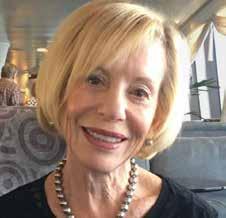
Throughout her life, Rebecca assembled a wide circle of friends due to her sweet disposition, kindness, and unforgettable smile. She was a master bridge player, an avid ballerina, and a tireless volunteer for the Jewish community. She loved collecting paperweights and never missed an opportunity to share photos of and brag about her precious grandchildren.
Above all, Rebecca’s greatest joy was her family. She is survived by her husband, Norman Nirenblatt; her children, Samuel, Morris, and David (Allison); her stepchildren, Bradley (Cynthia) and Amy (Robert); and her devoted grandchildren, Alan, Sara, Jordan, Maddie, Lilly, and Ryan Srochi; Ellen and Daniel Nirenblatt, and Eric (Carli), Johnny, and Billy Lawrence, and former daughters-in-law, Dina Sack and Julie Srochi. Additional survivors include her brother, Joe (Diane) Marcus, brother-in-law, Norman Estroff; and sister-in-law, Marilyn Hoffman. In addition to her parents, Rebecca was preceded in death by her husband, Alan, and son, Nathan.
Special thanks from the Srochi family to The Sullivan House and Ennoble Hospice for the extraordinary care given to Rebecca in her last months of life.
Graveside services were held on Tuesday, Oct. 28, at 10 a.m. at Greenwood Cemetery with Rabbi Joshua Heller officiating. In lieu of flowers, the family asks that memorial contributions be directed to The Sullivan House, Ennoble Hospice, or the charity of your choice. Arrangements by Dressler’s Jewish Funeral Care, 770-451-4999.










CLOSING THOUGHTS
Time Flies No Matter Which Calendar You Use

Shaindle
Schmuckler
Shaindle’s Shpiel
First, let’s look at the solar calendar.
The solar calendar is where we acknowledge that Jan. 1 is always the first day of the year, and Dec. 31 is always the last day of the year. These dates do not change each year. We depend on its consistency.
It is the calendar we all use to mark time. This same calendar is also used to mark special, and not so special occasions, all the dates we need to remember. It is this calendar I depend on to ensure I remember the birthdays and anniversaries of my friends, my extended family, and of course, my immediate
family.
I know what you are thinking -how can she not remember her family’s birthdays, anniversaries, special occasions, or important events. Well, I will admit to you, my dear readers, my brain is so full of information (not always relevant to anything in particular), I only have room to store some portions of it.
Then, there is the issue of some of this information getting lost along the way. No matter how hard I try, I can’t find it all. (Could it all be in the one locked closet I have not checked yet?)
Hence, I employ the very tried and true method of recording everything on my paper calendar. I can’t quite trust myself in any other forms of date keeping.
Does time really fly by when you are having fun?
It is my humble opinion, whether you are having fun or are in a state of perpetual frustration, time will fly no matter what your state of mind hap -
pens to be. Trust me when I tell you time does not wait for you to catch up.
A clever and insightful good friend once shared this prophetic statement with me: after the age of 55 … 10 years pass as if it were one year. OMG he was right!
I am personally still adjusting to the fact that Chanukah 2024 is over and long gone. Chanukah 2025 will be here so soon we had better begin creating the “Chanukah wish list.”
Now, let’s look at the Shaindle calendar.
My personal calendar has a very special place in my heart; you will soon see why.
My calendar is divided into two separate segments. Part one of this calendar begins the day after Labor Day, unless Labor Day is on a Saturday, then it begins two days after Labor Day. This is otherwise known as the first day of school and concludes on June 30, otherwise known as the last day of school.
Somehow, keeping this all straight has never been an issue for me.
In the second segment, you will not find the word school anywhere. There is no school during this time. This was my sacred time of the year. Summer camp was the only item on my summer agenda.
Let’s look at the Jewish calendar, which is a lunar calendar.
This calendar year begins around the same time as the first segment of my two-part calendar year. This segment is in early fall coinciding with the beginning of the school year.
The Jewish calendar does not align with the solar calendar, since the first day of the Jewish calendar changes from year to year. Truth be known, the Jewish calendar has more than one New Year.
Let’s keep this for another conversation. Calendars! How can we function without them? How would we mark time or witness time flying by? ì



